Плюсы и минусы инженерной доски
Выбирая инженерную доску в качестве напольного покрытия в квартире или доме, важно узнать о ее плюсах и минусах. Об этом речь в статье
Выбирая инженерную доску в качестве напольного покрытия в квартире или доме, важно узнать о ее плюсах и минусах. Нельзя рассматривать материал только, с эстетической точки зрения, хотя и здесь он стоит в одном ряду с паркетом. 
Статья опишет нюансы достоинств и недостатков покрытия.
Содержание:
-
Что такое инженерная доска
-
Преимущества и недостатки инженерной доски для конкретных условий
-
Заключение
Что такое инженерная доска
Покрытие представляет собой двухслойную или трехслойную доску.  Последний вариант схож с паркетом, но в отличие от натуральной древесины, этот напольный материал не совсем натурален, так как содержит продукт деревообработки – фанеру. Ее слои склеены между собой клеем с силиконовыми добавками. Декоративный верхний лицевой слой – пиленый шпон из ценной древесины. Подробнее о размерах – здесь. От параметров зависят прочностные качества покрытия.
Последний вариант схож с паркетом, но в отличие от натуральной древесины, этот напольный материал не совсем натурален, так как содержит продукт деревообработки – фанеру. Ее слои склеены между собой клеем с силиконовыми добавками. Декоративный верхний лицевой слой – пиленый шпон из ценной древесины. Подробнее о размерах – здесь. От параметров зависят прочностные качества покрытия.
Виды
Помимо классификации на количество слоев, инженерная доска делится по следующим типам:
1. Метод распила верхнего слоя.  Параметр идентичен классификации паркета. Сорта – селект, натур, рустикал – подчеркивают природный рисунок дерева. В первом случае недопустимы дефекты – сучки, контрастные переходы тонов. Полы становятся единой площадью. Во втором – они допускаются в небольших количествах. В третьем – покрытие пестрое из-за вкраплений и переходов цвета. Соответственна и цена.
Параметр идентичен классификации паркета. Сорта – селект, натур, рустикал – подчеркивают природный рисунок дерева. В первом случае недопустимы дефекты – сучки, контрастные переходы тонов. Полы становятся единой площадью. Во втором – они допускаются в небольших количествах. В третьем – покрытие пестрое из-за вкраплений и переходов цвета. Соответственна и цена.
 Нередко в дизайне используют метод старения – полы напоминают видавшие виды, но без потери прочностных характеристик.
Нередко в дизайне используют метод старения – полы напоминают видавшие виды, но без потери прочностных характеристик. 
3. Количество полос. Инженерная доска содержит от одного до трех полос лицевого слоя.
 Последний экземпляр идентичен штучному паркету из-за размеров плашек.
Последний экземпляр идентичен штучному паркету из-за размеров плашек.
Совет – выбирая инженерную доску для укладки в одну комнату, важно определиться сразу с внешним видом и количеством материала. Потом подобрать общий тон и количество полос верхнего слоя – трудно. В случае несоответствия и невозможности приобрести аналогичную доску, покрытие циклюют и тонируют.
Преимущества и недостатки инженерной доски для конкретных условий
У деревянного напольного покрытия есть плюсы и минусы, присущие природному материалу. Важно рассматривать инженерную доску, с точки зрения долговечности, для каждой комнаты, куда предполагается ее стелить. Рассмотрим подробно:
Гостиная
Для нее паркетная доска – идеальное решение. 
1. Войлочные или каучуковые подкладки под ножки мебели.
2. Своевременный уход.
Спальня
Встать на теплый пол после сна – великолепное ощущение.  Природный материал не требует дополнительных систем обогрева благодаря своей структуре, но приемлет электрическую или пленочную сеть. Водяные теплые полы для разновидностей деревянных покрытий – запрещены ввиду случайной возможной протечки. Долговечность инженерной доски в спальне увеличивается благодаря невысокой проходной активности и защите ворсовым покрытием – ковром, паласом. Условия по уходу – аналогичны.
Природный материал не требует дополнительных систем обогрева благодаря своей структуре, но приемлет электрическую или пленочную сеть. Водяные теплые полы для разновидностей деревянных покрытий – запрещены ввиду случайной возможной протечки. Долговечность инженерной доски в спальне увеличивается благодаря невысокой проходной активности и защите ворсовым покрытием – ковром, паласом. Условия по уходу – аналогичны.
Детские
Большое достоинство инженерной доски в детской комнате – ее натуральность слоев, а, следовательно, экологичность.  От покрытия нельзя получить аллергических реакций, оно не статично, содержание в клее силиконовых добавок не влияет на атмосферу детской комнаты. Однако, проходимость детской комнаты повышена, следовательно, там требуются внушительные параметры инженерной доски. Она имеет широкий размерный ряд – еще одно ее достоинство.
От покрытия нельзя получить аллергических реакций, оно не статично, содержание в клее силиконовых добавок не влияет на атмосферу детской комнаты. Однако, проходимость детской комнаты повышена, следовательно, там требуются внушительные параметры инженерной доски. Она имеет широкий размерный ряд – еще одно ее достоинство.
Кухня, прихожие, ванные и санузлы
К сожалению, главный минус любой натуральной деревянной доски, несмотря на количество слоев и стабилизирующие слой – боязнь влаги.  У инженерной доски она проявляется меньше чем у паркета, но, тем не менее в большей степени, чем у ламината. Поэтому в качестве напольного покрытия в ванных, санузлах или кухнях, инженерная доска – не рекомендована. Помещения отличаются агрессивной и влажной средой. К тому же доска обладает способностью впитывать запахи.
У инженерной доски она проявляется меньше чем у паркета, но, тем не менее в большей степени, чем у ламината. Поэтому в качестве напольного покрытия в ванных, санузлах или кухнях, инженерная доска – не рекомендована. Помещения отличаются агрессивной и влажной средой. К тому же доска обладает способностью впитывать запахи.
Для прихожих, инженерная доска неприемлема по причине всех агрессивных факторов – влаги, перепадов температур, грязи. Этот участок в квартире или доме обладает самой высокой активной проходимостью. Требования к уборке, повышенные – ежедневная сухая чистка с удалением пятен.  Содержание в первоначальном виде инженерной доски – хлопотно и практически невозможно.
Содержание в первоначальном виде инженерной доски – хлопотно и практически невозможно.
Заключение
Подытожим. В число плюсов инженерной доски входят: экологичность материала, прочность, красота, возможность самостоятельной укладки и стабильность пола при соответствующих условиях. Минусы: боязнь влаги, требования к уходу, регулярное обновление лицевого слоя и недолговечность в случае неправильного подбора доски по параметрам. Сгладить негативные впечатления и наслаждаться красотой покрытия, возможно, только при условии выполнения рекомендаций для выбора инженерной доски в каждую комнату.
Если вы нашли ошибку, пожалуйста, выделите фрагмент текста и нажмите Ctrl+Enter.
особенности, плюсы и минусы, фото
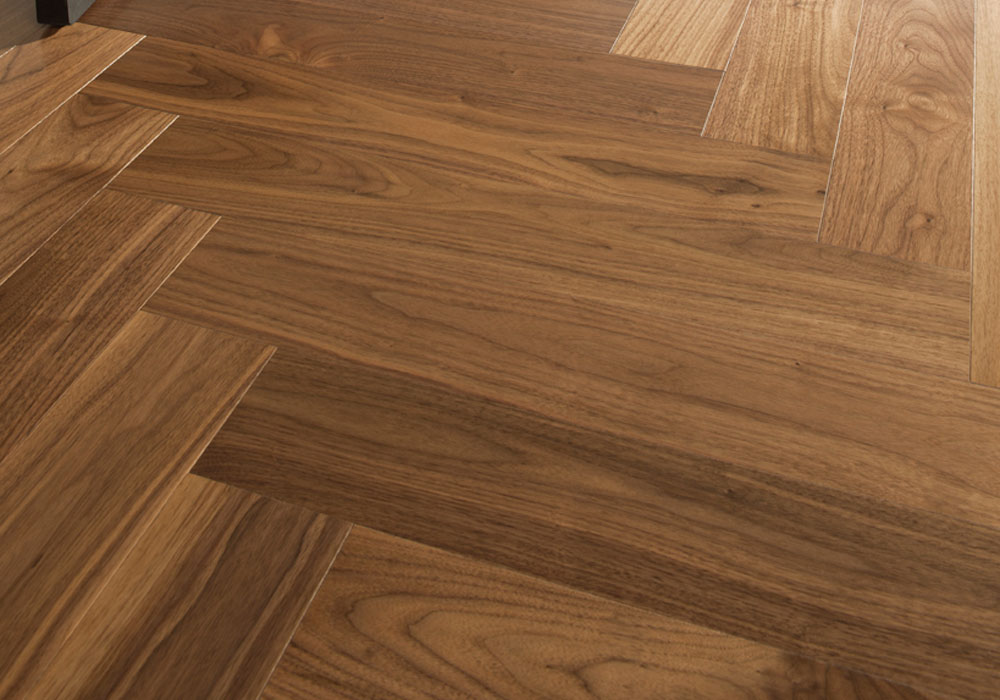
- Из чего состоит инженерная доска?
- Какие преимущества и недостатки имеет данный материал?
- Какие существуют разновидности инженерной доски?
- Как выбрать наиболее подходящий вариант отделки?
- Какими способами укладывают инженерную доску?
Структура и особенности изготовления инженерной доски
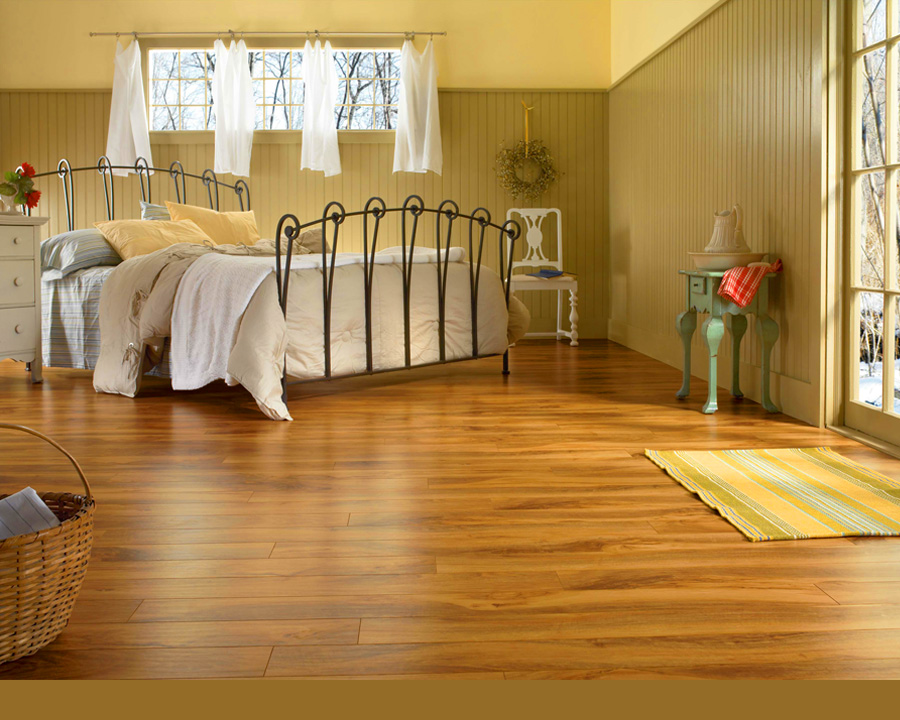
В первом случае основанием служит фанера. Его толщина варьируется в переделах от 5 до 15 мм. Верхний слой (декоративный шпон) изготавливают из массива ценных пород древесины.
При производстве трехслойной инженерной доски между фанерой и финишным слоем укладывают рейки из ели или сосны. Причем делают так, чтобы волокна располагались перпендикулярно верхнему и нижнему слоям. Это придает материалу повышенную стабильность.
На изготовление верхнего слоя идут как распространенные породы древесины, так и экзотические. Толщину декоративного шпона варьируют в пределах от 4 до 8 мм.
Обратите внимание! Чем толще верхний слой, тем большее количество раз можно обновлять напольные покрытия. К примеру, инженерную доску с 5-миллиметровым декоративным шпоном можно шлифовать 4 раза.
Производство имеет следующие особенности:
Для защиты от влаги и истирания инженерная доска покрывается лаками и другими специальными составами.
Для ускорения монтажных работ производители выпускают материалы с замковыми соединениями. Чаще всего встречаются пазогребневые, шпонковые и защелкивающиеся замки.
Для подчеркивания фактуры досок и улучшения их эстетических качеств производители используют морение, браширование, копчение и иные технологии.
Инженерная доска может иметь следующие габариты.
Длина — 0,5–6 м.
Ширина — 0,13–0,45 м.
Как видите, длина и ширина инженерных досок превышают соответствующие характеристики паркетных.
Плюсы инженерной доски
Инженерная доска имеет следующие достоинства.
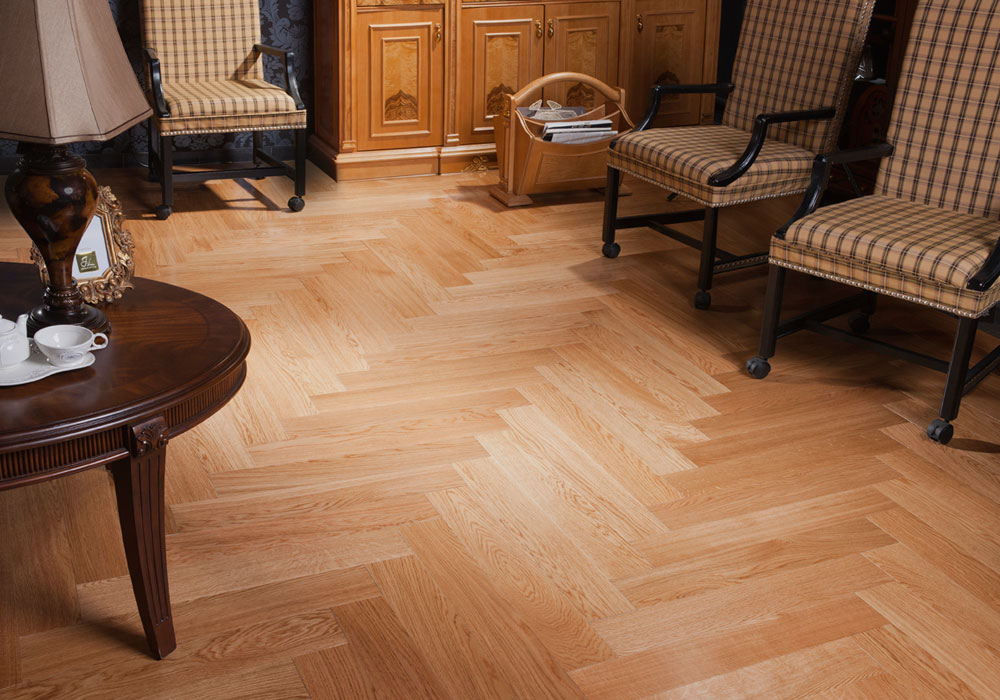
- Высокая стабильность. Инженерная доска лучше паркетной сопротивляется перепадам температур.
- Долговечность. Напольные покрытия при соблюдении условий эксплуатации служат до 40 лет. Причем, как уже было сказано, поверхность можно несколько раз шлифовать.
- Легкость ремонта. При шлифовке инженерная доска не снимается.
- Высокая скорость монтажа. Отделочные работы проходят очень быстро. Причем при креплении не нужно соблюдать технологические зазоры.
- Возможность укладки в различных помещениях. При обустройстве полов в зонах с высокими влажностью и нагрузками используют инженерные доски, верхние слои которых изготовлены из влагостойких и очень прочных пород древесины.
- Отличная звукоизоляция. Для максимального повышения этой характеристики инженерная доска укладывается на специальную акустическую подложку.
- Большое количество вариантов монтажа. Инженерную доску укладывают елочкой, палубным, смешанным иными методами.
- Широкий выбор дизайнерских решений. Можно подобрать материал под любой интерьер. Некоторые производители предлагают даже фигурные ламели, имитирующие вручную изготовленные доски.
- Кроме этого, инженерная доска отлично комбинируется с системами теплых полов.
Минусы инженерной доски
Выделяют следующие недостатки инженерной доски.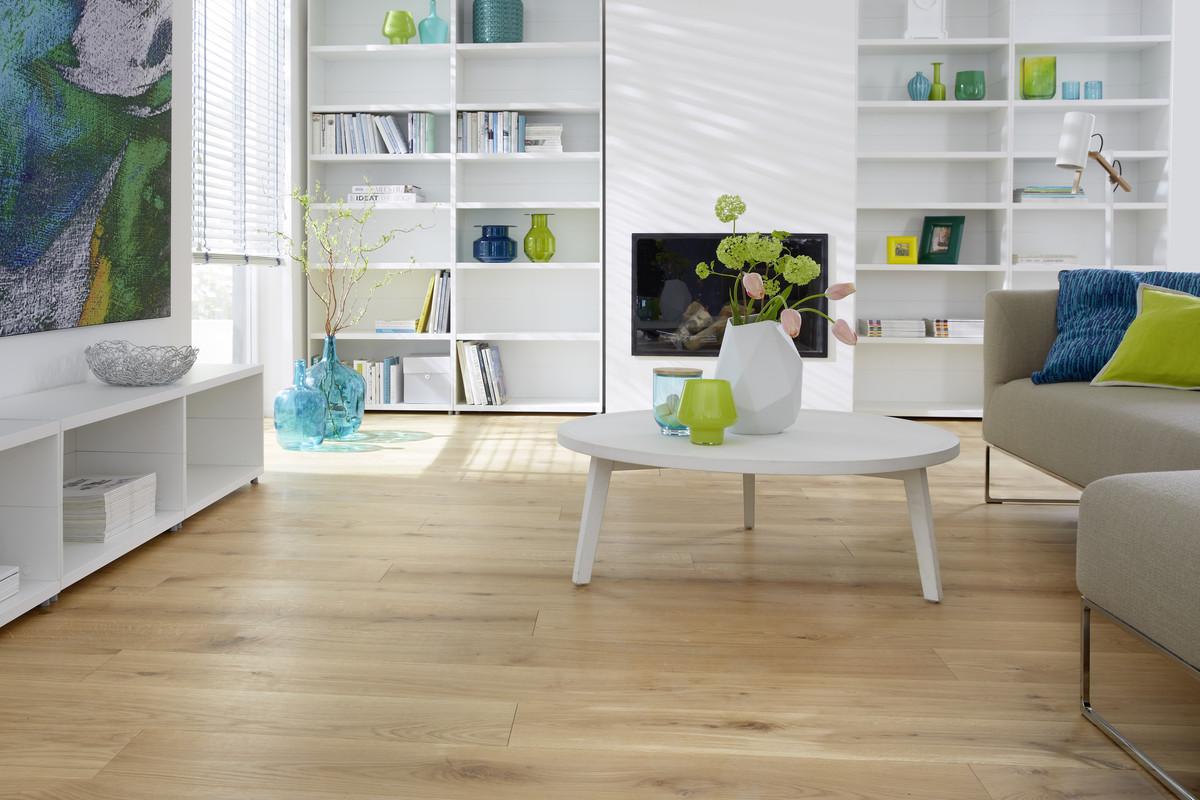
- Высокая цена. Инженерная доска стоит дороже многих других напольных покрытий.
- Низкая влагостойкость. Даже при использовании специальных материалов нельзя допускать их длительного контакта с водой.
- Невозможность демонтажа испорченных ламелей, уложенных клеевым способом. Разобрать можно только покрытие, установленное по плавающей технологии.
- Необходимость покупки небольшого запаса материалов. Если одна или несколько инженерных досок повредятся, подобрать подходящие по цвету и фактуре ламели будет проблематично. Поэтому рекомендуется покупать материалы с небольшим запасом и хранить их в надлежащих условиях.
Разновидности инженерной доски
При изготовлении верхних слоев инженерных досок используют древесину, полученную тремя способами распила.
- Рустикальный — под различными углами.
- Тангенциальный — по касательным к толщине стволов.
- Радиальный — вдоль волокон.
После изготовления доски распределяют по сортам. При селекции специалисты учитывают способ распила, наличие дефектов, а также фактуру и цвет древесины. Всего выделяют три сорта инженерной доски.
«Рустик». На изготовление верхних слоев идут доски, полученные рустикальным методом распила. Они могут отличаться по цвету и фактуре. Допускается наличие различных дефектов. Кстати, инженерная доска этого сорта выглядит натурально. По этой причине, а также из-за низкой стоимости этот материал предпочитают многие потребители.
«Натур». Доски, идущие на изготовление декоративного шпона, получены радиальным и тангенциальным методами распила. Для этого сорта инженерной доски характерны небольшие различия по цвету и фактуре, а также наличие незначительных дефектов. Стоимость — средняя.
«Селект». Инженерная доска этого сорта изготавливается только с применением материалов, полученных радиальным методом распила. Ламели идеально подобраны по цвету и фактуре. Дефекты полностью отсутствуют. Инженерная доска сорта «селект» стоит дороже аналогов.
Как выбрать инженерную доску
Чтобы инженерная доска прослужила как можно дольше, учитывайте при выборе отделочного материала три важных фактора.
- Нагрузки. В помещениях с высокой проходимостью и тяжелой мебелью укладывают небольшие инженерные доски. При минимальных нагрузках подойдут и крупные.
- Влажность. Для обустройства напольных покрытий в помещениях с повышенной влажностью используют инженерные доски, верхние слои которых изготовлены из влагостойких пород древесины. К ним относятся термоясень, тис и др.
- Толщина декоративного шпона. Чем она больше, тем дольше прослужит напольное покрытие. Но толщина напрямую влияет на стоимость. При ограниченном бюджете выбирайте компромиссное решение. В противном случае инженерная доска максимальной толщины — лучший вариант отделки.
Способы монтажа
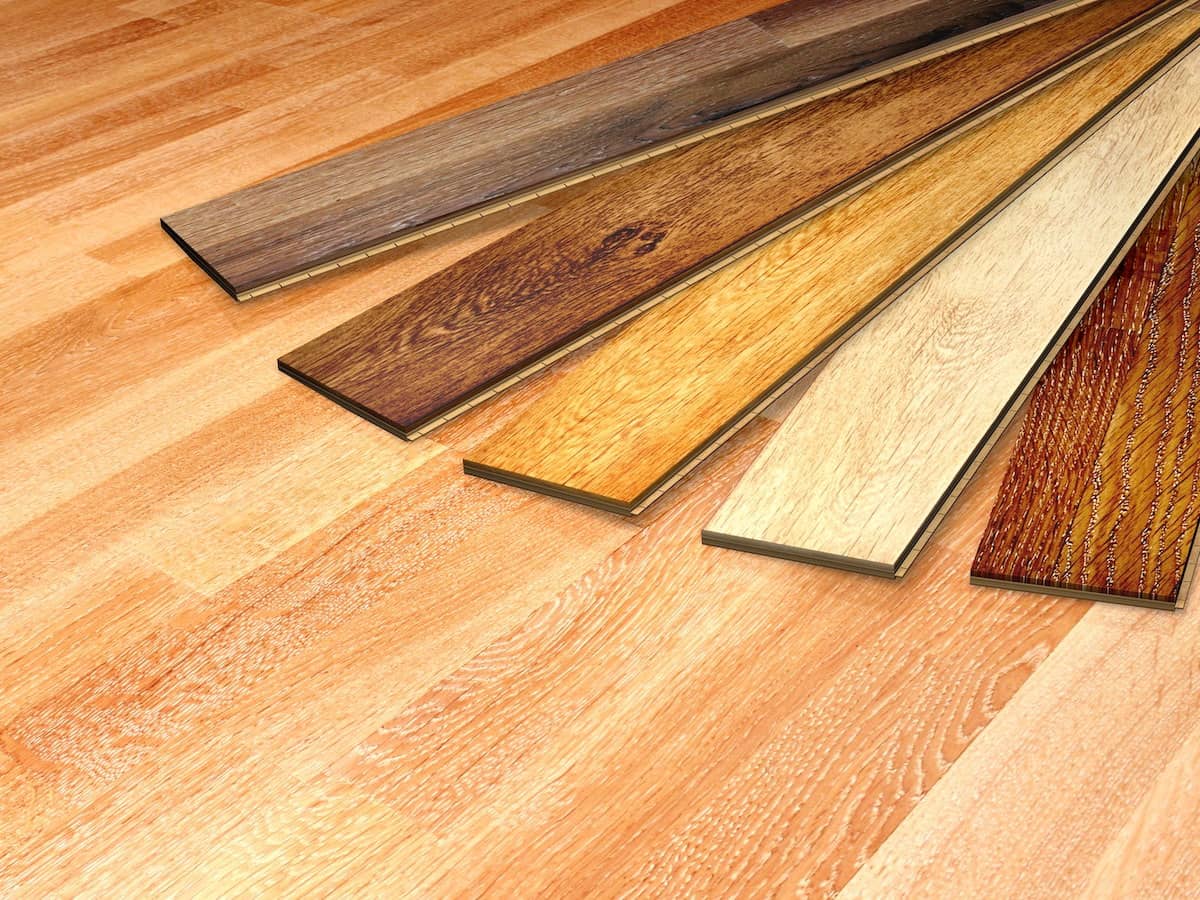 Инженерную доску обычно укладывают двумя способами.
Инженерную доску обычно укладывают двумя способами.
- Клеевой. Ламели устанавливают либо на подложку из фанеры, либо непосредственно на клей. Чтобы улучшить адгезионные свойства инженерные доски грунтуют. Если ламели крепят к фанерной подожке, для дополнительной надежности используют саморезы.
- Плавающий (подходит только для инженерных досок с замковыми соединениями). В этом случае ламели устанавливают на специальные влагостойкие акустические подложки и соединяют между собой. Этот способ выигрывает не только в плане скорости. Напольное покрытие можно несколько раз демонтировать и собирать заново.
Обратите внимание! Монтаж инженерных досок, если вы не обладаете опытом и навыками, стоит доверить профессионалам. Так вы избежите возможных проблем и получите гарантию.
Можно ли укладывать инженерную доску на кухню
Влагостойкая инженерная доска для кухни – сравнительно молодой вид паркета, который стремительно набирает популярность. Широкое применение и спрос этот материал получил благодаря высоким техническим свойствам и разнообразию оттенков и декоров. И если вы не уверены, что инженерная доска подойдет для укладки на кухне, то отбросьте свои сомнения. Напольное покрытие просто незаменимо по ряду причин:-
гладкая фактура ламелей позволяет содержать пол в идеальной чистоте;
-
в случае порчи, отдельные участки инженерной доски легко заменить, если укладка была осуществлена «плавающим» методом;
-
древесина отлично переносит частые влажные уборки, не впитывает пролитую жидкость и легко очищается при помощи теплой воды и специальных моющих средств;
-
внешний вид ламелей не страдает от попадания жира на поверхность материала.
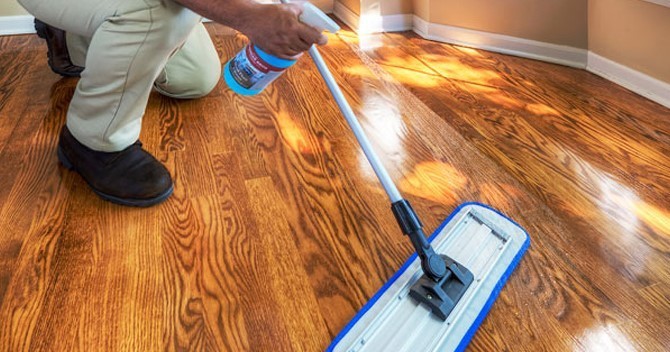
Учитывайте, что способ укладки ламелей значительно влияет на визуальное восприятие пространства. Если вы уложите их вдоль стены, то помещение визуально удлинится, а если проложите по диагонали, то расширится. Крупные паркетные доски зрительно сужают пространство, а узкие наоборот – расширяют его.
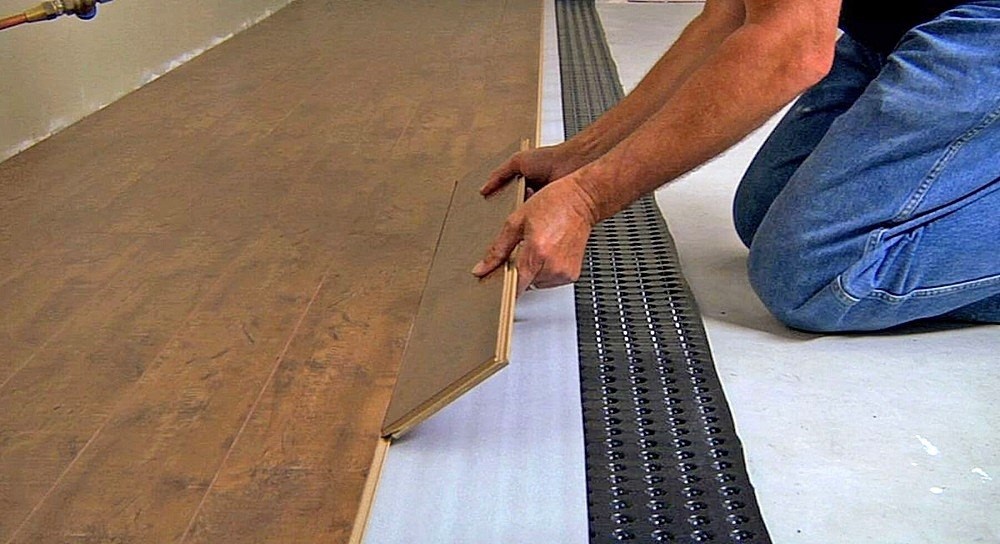
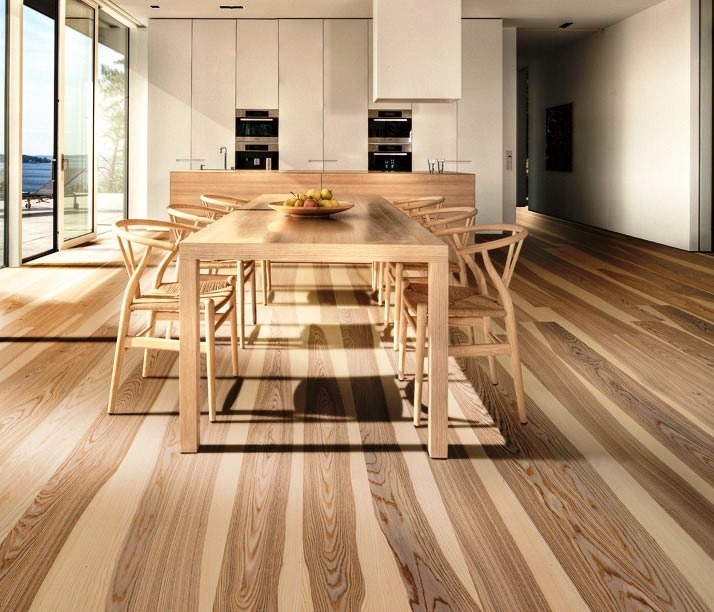
В кухонной комнате инженерная доска пролежит дольше, если выбирать ламели, изготовленные их тех сортов древесины, которые нейтральны по отношению к воде. Это дуб, тик, ясень, американский орех, мербау и лиственница.
Плюсы и минусы инженерной доски на кухне
Выбор пола нелегкое дело. Какое покрытие лучше? Какой материал прослужит дольше? Именно эти вопросы заботят людей в первую очередь. Инженерная доска на кухне имеет свои плюсы и минусы, поэтому прежде чем приобретать напольное покрытие, необходимо тщательно ознакомиться с его особенностями, изучить особенности ламелей и только после этого принимать решение о покупке товара.
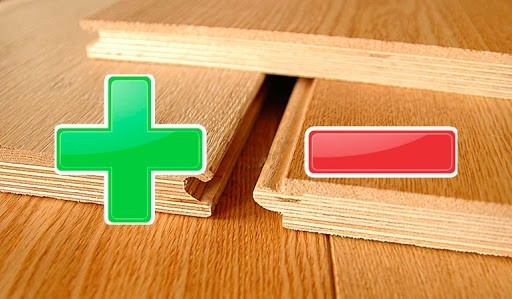
Преимущества инженерной доски:
- Так как материал клееный, он практически не подвержен деформации и обладает наиболее высокой геометрической стабильностью по сравнению с другими деревянными напольными покрытиями;
-
Инженерная доска для пола на кухню обладает повышенной прочностью и устойчивостью как к механическим воздействиям, так и климатическим условиям, поэтому служит минимум 25 лет;
-
Покрытие обработано слоем масла или лака таким образом, чтобы исключить попадание влаги в толщу материала, предотвратить его разбухание;
-
Ламели можно неоднократно обновлять и реставрировать с помощью циклевки и шлифовки;
-
Материал обладает естественным теплом древесины, по нему приятно ходить босиком;
-
Инженерную доску на кухне можно укладывать как клеевым, так и плавающим способом, монтировать ее на систему теплых полов;
-
Замочный способ соединения позволяет добиться абсолютной гладкости и однородности пола, не оставляя ни единого зазора;
-
Широкий выбор размеров позволяет решить все задачи по оформлению любого пространства;
-
Напольное покрытие, выпущенное в продажу, полностью готово к использованию и не нуждается в дополнительной обработке различными составами.
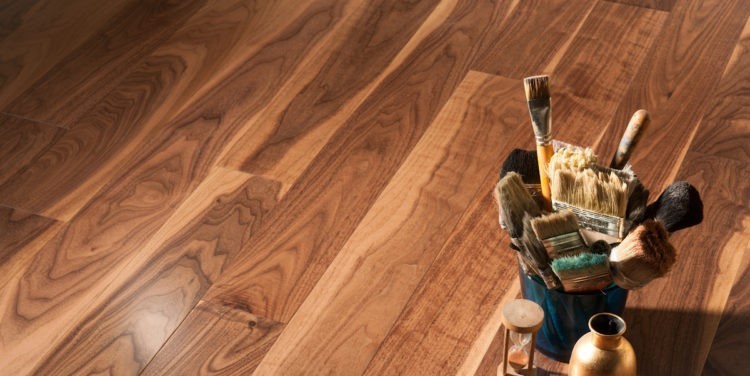
Недостатки инженерной доски:
-
Покрытие из некоторых типов досок трудно демонтировать, а потом вновь установить;
-
Процесс укладки ламелей – достаточно кропотливый труд, поэтому лучше всего доверить работу профессионалу;
-
Расценки на инженерную доску не самые низкие, поэтому ее нельзя включить в категорию бюджетных стройматериалов.
- Рынок стройматериалов наполнен подделками, поэтому инженерную доску лучше приобретать у проверенных поставщиков, в надежных интернет-магазинах.
Сопоставляя все плюсы и минусы инженерной доски, можно с уверенностью сказать, что данное напольное покрытие является практически идеальным вариантом для укладки на кухне и в других помещениях, в которых наблюдается повышенная влажность. Более износостойкого, прочного и эстетически привлекательного материала на сегодняшний день просто не существует.
Инженерная доска в интерьере кухни
На российском рынке свою продукцию представляют немало разных производителей: зарубежных, отечественных и совместных. Для того чтобы не потратить деньги впустую и приобрести действительно качественное напольное покрытие, нужно отдавать предпочтение изделиям популярных и успевших зарекомендовать себя среди потребителей брендов.
Инженерная доска Wood Bee
Голландская компания производит эталонные покрытия, изготовленные из натуральной древесины. Ламели имеют отличные показатели влагостойкости, выдерживают температурные колебания и существенные механические нагрузки. Все эти особенности делают материал практически незаменимым, укладывать инженерную доску можно на кухне и в коридоре, а также в другие помещения с высокой проходимостью.
Материал представлен в широком цветовом диапазоне, поэтому подобрать нужный оттенок доски не составит труда. Чаще всего потребители выбирают выбеленные ламели, изготовленные из дуба и ясеня, ведь при помощи них можно зрительно расширить пространство, сделать комнату светлее и просторнее. Не отстают по популярности покрытия темных оттенков: коричневого, серого или черного цветов. Такие полы придают помещению респектабельности, выглядят эффектно и уместны практически в любом стилевом решении.
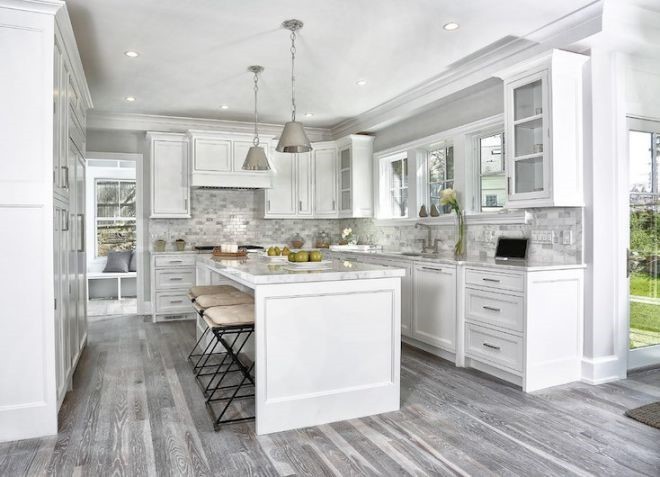
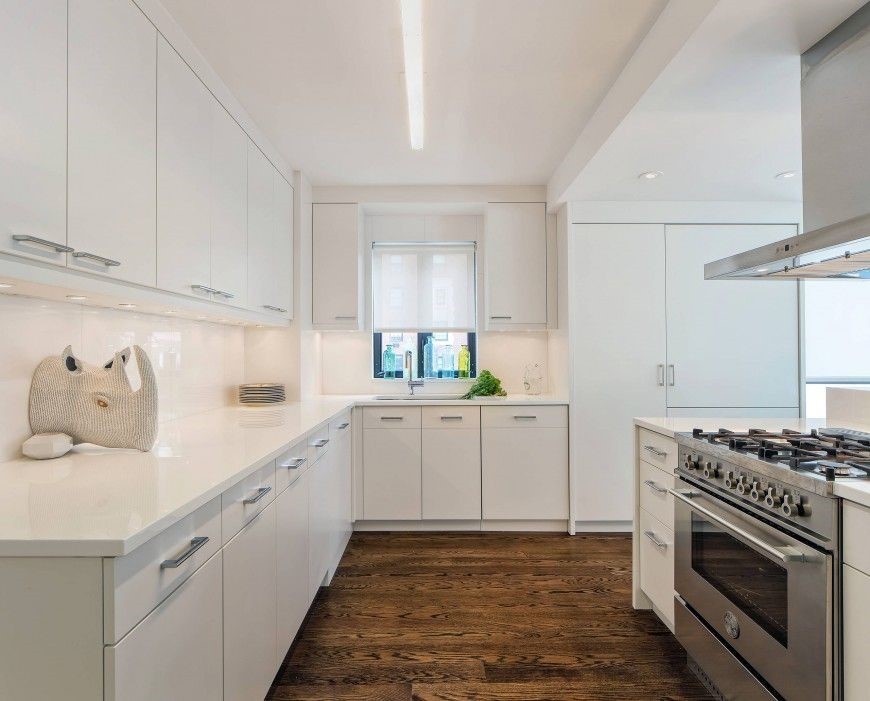
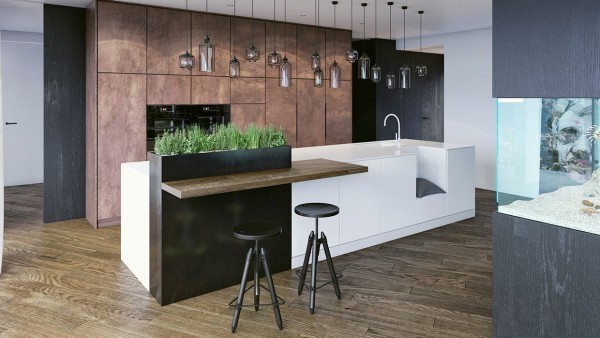
Инженерная доска дает возможность уложить пол без порожков, а для стыковки с другими материалами, например, керамической плиткой, можно использовать пробковые компенсаторы.
Инженерная доска Global Parquet
Американская компания Global Parquet специализируется на производстве инженерной доски из самых долговечных и востребованных пород древесины (Дуб, Американский Орех, Бирманский тик и Ясень). Материал обладает высокой износостойкостью и долговечностью благодаря покрытию лицевой стороны ламелей 8 слоями высокотехнологичного лака Treffert (Германия) и двумя слоями оксида алюминия. Все перечисленные достоинства продукции наряду с уникальными дизайнами коллекций позволяют отнести ее к уникальным напольным покрытиям премиум-класса.
Если кухня плохо освещена, а ее окна выходят на северную сторону, желательно выбирать светлые оттенки паркетной доски. Ламели рыжеватого цвета сделают кухню уютной и теплой, а темные покрытия – солидной. Материал имеет стабилизированную многослойную конструкцию, не деформируется даже под значительными нагрузками, отличается особой прочностью к истиранию декоративного слоя и выглядит просто потрясающе в рамках любого интерьера.
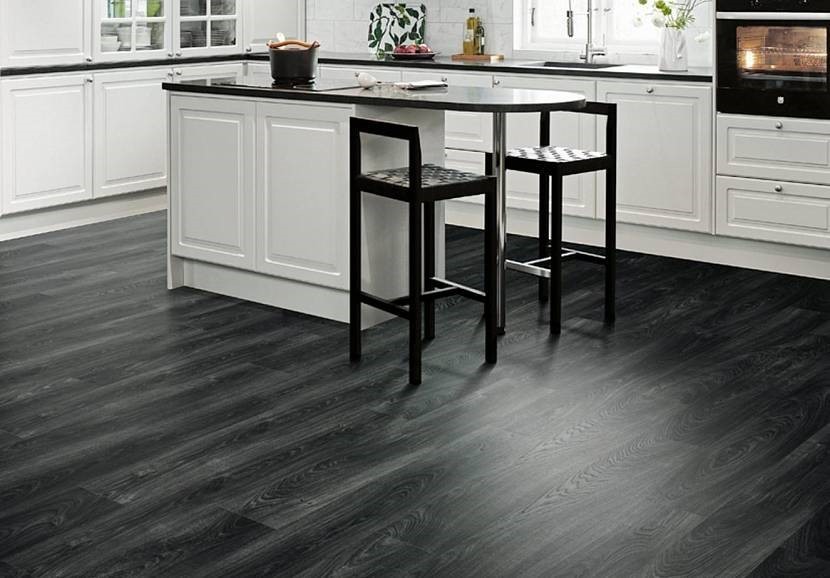
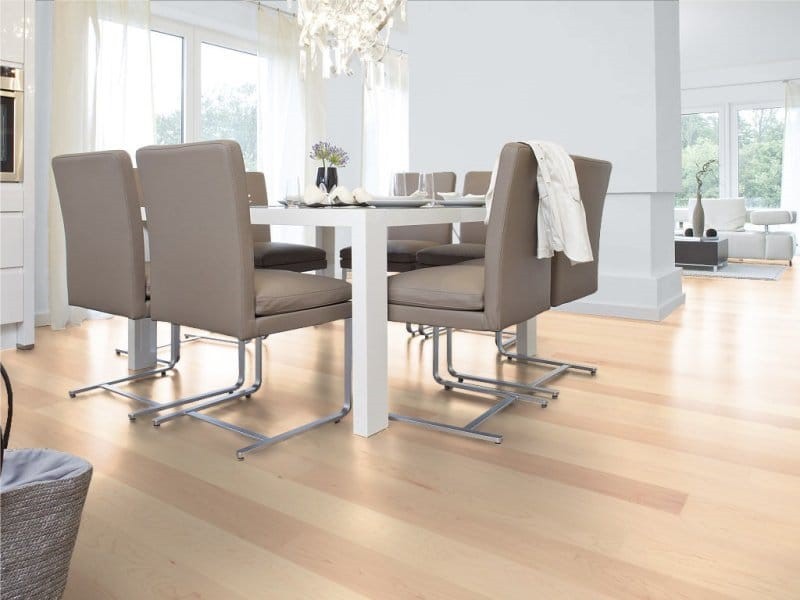
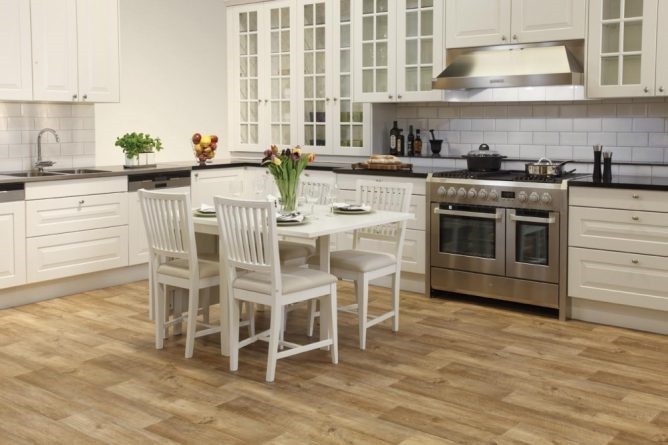
Инженерная доска для укладки на кухне и прихожей характеризуется отличными звукоизоляционными свойствами, не требует поддержания одного уровня температуры в помещении и не впитывает влагу. В коллекции присутствуют классические ретро-мотивы и актуальные решения 2000-ых, а цветовая гамма отражает самые модные тенденции в современном мире паркета.
Инженерная доска для пола — плюсы и минусы выбора
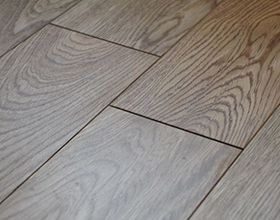
В современном дизайне интерьера приветствуются естественность и минимализм. Это касается не только эстетической составляющей оформления, но также выбора качественных натуральных материалов, которые долго служат и создают уютную атмосферу внутри помещений. В последнее время большим спросом пользуется инженерная доска — простое и надёжное решение по отделке домов, студий и просторных залов. Рассмотрим подробнее новинку со всеми её преимуществами и недостатками.
Что такое инженерная доска
Всё чаще для оформления полов в интерьере используют техномассив — многослойные отделочные покрытия, значительно повышающие прочность и эргономичность материала. Одним из новых таких продуктов стала инженерная доска, которая сочетает с себе характеристики паркетного и цельно-дощатого пола. Такой материал называют модульным, поскольку он включает несколько компонентов — как массивную, так и вторичную древесину.
Инженерная доска представляет собой композит из 2-3 слоёв с профилированием для соединения элементов:
- Базовый лист — это берёзовая фанера высокого качества, он необходим для обеспечения высокой прочности, выносливости и долговечности материала. Толщина базы варьируется от 6 до 16 мм.
- Внешний декоративный слой делают из шпона ценных пород, чтобы придать доскам благородный вид. Этот слой может составлять до 7 мм и иметь любое эстетическое оформление.
- Готовые доски покрывают лаком или восковым составом, чтобы обеспечить санитарно-гигиеническую пригодность и износостойскость материала. Облицовка может придавать покрытию различные оттенки, эффект старины, потёртости, максимально естественный вид вроде “ручной работы” и т.п.
- Соединительные элементы материала делают в нескольких вариантах: замочные с защёлкой, пазо-гребневые, шпонковые. Благодаря этому можно выбирать различные способы укладки доски в любых условиях.
Отличительно чертой инженерных досок является соединение слоёв перпендикулярно направленными волокнами, благодаря чему достигается высокая устойчивость и проходная нагрузка материала, теплоизоляция и дополнительная защита от разрушения в агрессивных средовых условиях.
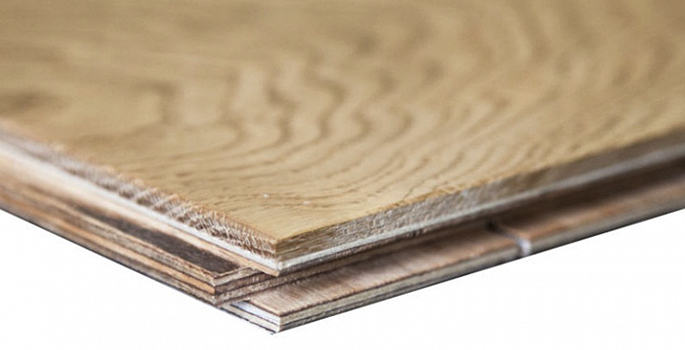
Особенности и преимущества инженерной доски
Такой вариант отделки пола выбирают всё чаще, поскольку материал открывает ряд преимуществ перед хозяевами помещения:
- Главное — это долговечность. Инженерная доска обладает повышенной прочностью и устойчивостью, как к механическим воздействиям, так и климатическим условиям, поэтому служит до 40 лет.
- Материал скомпанован и обработан таким образом, чтобы исключить попадание влаги, поражение вредителями и истирание, а его пропитка и покрытие, а также монтажный клей — экологически чисты и безопасны.
- Толстый верхний слой шпона позволяет обновлять доски до 4 раз, включая циклёвку, восстановление покрытия и реставрацию пола путём замены досок. При этом внешний вид и надёжность материала не пострадают.
- Инженерные особенности таких досок позволяют производителю готовить элементы любого формата: как стандартные, так и на заказ по заданным меркам, а кроме того, сегодня можно встретить криволинейные доски для воссоздания пола ручной работы.
- Возможность различных обработок внешнего слоя открывают перед покупателем большой выбор дизайна: затемнённая и тонированная, проморенная, “состаренная” древесина, всевозможные дополнительные эффекты. Таким образом можно реализовать любые дизайнерские замыслы.
- Такое покрытие отлично сочетается с системами тёплого пола различного типа и не препятствует монтажу дополнительных конструкций.
- Помимо прочего, материал обеспечивает отличную шумоизоляцию и хорошо удерживает тепло, поэтому не требует дополнительных прокладок и затрат.
- Дощатая отделка смотрится поистине богато и максимально натурально, что позволяет сделать помещение стильным и добротно обустроенным.
- Несколько вариантов монтажа позволяют проводить работы удобно и с учётом всех особенностей дизайна.
- Выложить покрытие можно как классическим палубным способом, так и фигурно — углом или нестандартным рисунком.
- Элементы можно использовать как внутри комнат, так и под открытым небом, при этом остаётся достаточный выбор черновых материалов — от стяжки до фанеры.
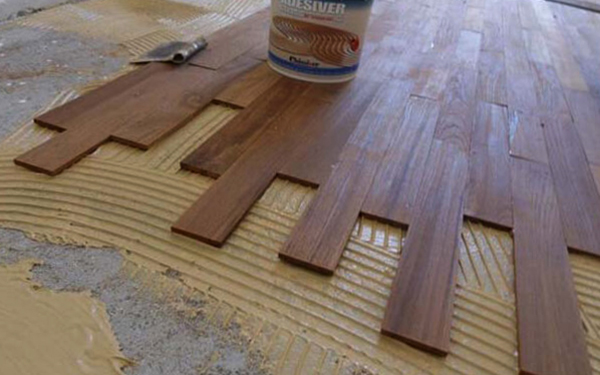
Инженерная доска — это новое слово в строительстве и оформлении внутреннего дизайна, вытеснившее менее удобные и универсальные паркет, массивные доски и другие доступные заменители.
В чём недостатки инженерной доски для пола?
В целом материал сейчас высоко ценится и остаётся запрашиваемым даже среди передовых дизайнерских сетей в Европе и по всему миру. Объективных недочётов в нём нет, но можно отметить несколько минусов, которые могут смутить покупателя:
- Высокая стоимость. Нужно понимать, что такое покрытие делается “на века”, поэтому стоить дёшево оно не может. Конечно, для временных ремонтных решений инженерная доска вряд ли подойдёт, но оформить ею новый коттедж или холл — это справедливый и мудрый вклад в будущее.
- Сложность монтажа. Процесс укладки таких досок довольно кропотливый — необходимо провести точные замеры и осторожно сопоставить все элементы. При этом важную роль играет подготовительный этап и монтаж отопления. Тем не менее, последующая комфортная эксплуатация пола полностью оправдывает потраченные усилия.
- Толщина материала “съедает” пространство, поэтому такие полы актуально делать в крупных помещениях с высокими потолками. Для квартиры такое решение может оказаться нецелесообразным.
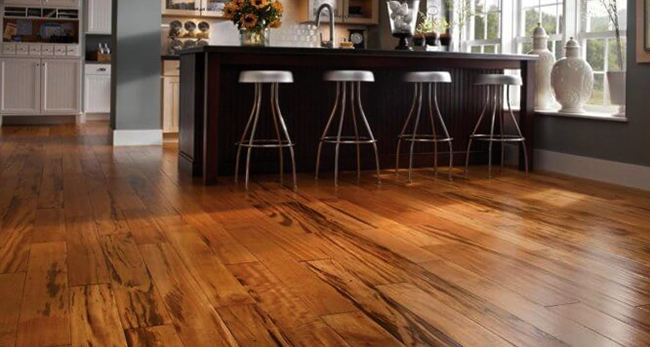
Как выбрать инженерную доску для ремонта
Если вы приняли решение выполнить пол из модульной доски, уделите достаточно внимания замерам, учитывая все припуски и толщину элементов. Чтобы не допустить ошибки, лучше всего проконсультироваться у производителя. Практически каждый изготовитель досок на заказ готов прислать мастера для снятия замеров.
Из приведенных аргументов “за” и “против” выбора инженерной доски в качестве напольного покрытия очевидно, что этот материал максимально комфортен, выгоден и к тому же органично впишется в любой интерьер.
Похожие записи
| Greenline | Россия | Дуб, ясень, орех | 2, 3 | 4 | художественный дизайн, соединение замковое либо «гребень-паз» |
| Mazarri | Россия | Кавказский дуб, ясень, американский орех. | 2, 3 | 4 мм, нижний влагостойкий | Браширование, патинирование, искусственное старение, тёс. Матовый, шелковисто-матовый, глянцевый масло/лак. |
| Legend | Россия -Белоруссия | Белорусский дуб | 3 | Верхний – 4 мм с лаковым покрытием в 11 подходов, средний содержит армирующую проволоку, нижний – влагостойкий | Соединение «шип-паз». Разные расцветки от тёмно-коричневого до выбеленного. |
| Godwin | Россия- Германия | Дуб, орех, ясень и др. | 2 | 4 мм | Лак с UF-отвердением. Монтаж – только клеевой способ. Не подходит для тёплого пола. |
| Kraft Parkett | Россия | Дуб | 2.3 | 4 до 6 | 7 слоёв лака. Ширина 150 или 180 мм, толщина 16 или 18 мм. Микрофаска. |
| Challe | Россия | Дуб | 2 | 3.5 | Замковое соединение. Браширование, 5 кратная лакировка. |
| Стародуб | Россия | Дуб | 2, 3 | 4 до 6, Нижний – влагостойкий | Браширование. Возможна укладка на тёплый пол. |
| Parkiet Hajnowka | Польша | Дуб, ясень | 2 | 4 | масло с UF-защитой. |
| Panaget | Франция | Французский дуб – 7 сортов. | 2 | 4 до 6 нижний – стабилизатор из хвойных пород | Натуральное масло, матовый и сатиновый (полуматовый) лаки. Основной цвет – светло-желтый. |
| Marco Ferutti | Италия | Орех, Дуб | 2 | 1,5, нижний – из эвкалипта. | UF-лак, соединение – «шип-паз». Браширование, основной цвет – тёмно-коричневый. Не подходит для тёплого пола. |
| Ribadao | Португалия | Американский орех, венге, афзелия, ироко, кумару | 2, 3 | 4 | Браширование, патинирование. матовый, шелковисто-матовый, глянцевый лак. Соединение – микрофаска или замковое. |
| Wood Ambiant | Голландия | Европейский дуб | 2 | 4 | Браширование, искусственное старение. Сортировка – рустик, с естественным рисунком, заболонью, глазками. Покрытие – многослойное лаковое. Укладка на клей с соединением «шип-паз». |
| Boen | Германия с производством в ФРГ, Норвегии и Литве | Дуб | 2 | 3.5 | Доска премиум класса. С нанесением масла с воском «Live Natural». Основной цвет – коричнево-пастельный. Торец – с фаской. |
| TarWood Тарвуд | Белоруссия | Дуб | 3 | Верхний – 4 мм с лаковым покрытием в 7 подходов, нижний – влагостойкий | Подходит для укладки на тёплый пол. Соединение «шип-паз». Разные расцветки от тёмно-коричневого до выбеленного. |
| AustriaWood | Австрия | Дуб | 2 | 6 | Премиум класс с ручной обработкой покрытия. Не подходит для тёплого пола. |
| Coswik Косвик | Канада с производством в Белоруссии | Ясень, канадский кедр | 2, 3 | 4 | Шелковое масло. Браширование. Основной цвет – тёмно-коричневый. С фаской. Не допускается монтаж на тёплый пол. |
| Ablux | Канада | Американский орех | 2, 3 | 4 | Шелковое масло. Браширование. Основной цвет – тёмно-коричневый. С фаской. Не допускается монтаж на тёплый пол. |
| Missouri | США | Американский орех | 2 | 4, Смешанный отбор древесины. | UF-лак или маслом, Соединение – «шип-паз». Обработка – браширование, основной цвет – тёмно-коричневый. Подходит для тёплого пола. |
| Amigo | Китай | Бамбук на HDF плите | 2 | 2 | УФ-лак. Соединение – «шип-паз». Браширование. Цвета разных оттенков – коричневые, золотистые, зеленые и выбеленные. |
| Global Parquet | Малайзия | Дуб | 2 | 3.5 | UF-лак, Селекционный отбор дерева. Соединение – «шип-паз». Браширование, основной цвет – тёмно-коричневый. Не подходит для тёплого пола. |
| Wood bee | Нидерланды с производством в Китае | Дуб | 3 | 3 | 7 слоёв полуматового лака, защита от ультрафиолета. Брашированные доски основного цвета – бежево-золотого. Не допускается укладка на тёплый пол. С фаской с 4 сторон. |
| Galathea | США с производством в Китае | Дуб, берёза, Зебрано, мербау, орех, сапелли, игровое дерево | 2 | 2 | с пропиткой маслом или защитой УФ-лаком. Смешанный отбор древесины. Соединение – «шип-паз». Браширование. Цвета разных оттенков – коричневые, золотистые, красные и выбеленные. |
Различия в структуре
Классическая паркетная доска имеет трехслойную структуру, не считая финишного покрытия лаком или маслом. Все три слоя располагаются перпендикулярно друг другу. В нижнем и среднем слое используется мягкое дерево: чаще всего это древесина хвойных пород, таких как ель и сосна. Иногда вместо этого в среднем слое используется ДВП высокой плотности. Верхний слой в паркетной доске — это всегда древесина ценных пород: здесь могут быть как экзотические, так и любые другие сорта. Толщина ценного слоя в паркетной доске варьируется от 0,6 мм (в шпонированной паркетной доске) до в среднем 4 мм.
Структура так называемой инженерной доски совсем другая. В ней всего два слоя: нижний — из березовой или эвкалиптовой фанеры, верхний — из ценных сортов древесины. Сорта те же, что и в паркетной доске, но толщина ценного слоя здесь заметно больше (никакого шпона, только массив). Таким образом, по структуре было бы правильнее сравнивать инженерную и массивную доску, с которой у нее гораздо больше общего, включая схожие размеры, из-за чего после укладки их часто путают.
Количество полос в верхнем слое
Паркетная доска может быть однополосной, двухполосной и трехполосной — по числу ламелей в ее верхнем слое. Если однополосная паркетная доска в верхнем слое представляет собой цельную плашку, то последние два вида состоят из склеенных между собой ламелей, что при неблагоприятных климатических условиях создает угрозу для их разрыва и появления микротрещин.
Инженерная доска всегда однополосная, поскольку ее верхний слой — это массив ценных сортов дерева. Внешне однополосная паркетная и инженерная доска схожи, когда уже уложены в интерьере.
Различия в замковом соединении
В паркетной доске, как правило, в среднем слое предусмотрено современное замковое соединение, благодаря которому доски между собой просто защелкиваются при укладке. Это может быть замок Uniclic, Multifit, Valinge, 5G или какой-то другой. У каждого бренда часто свои запатентованные замки. Замковая система облегчает процесс укладки и позволяет при необходимости пересобрать заново пол.
В инженерной доске в редких случаях тоже может иметь место замковое соединение, но ввиду особенностей укладки здесь оно не имеет особого смысла, а потому производители чаще всего выпускают инженерные доски со шпунтовым соединением. Доски соединяются с подбивкой инструментом на шип и паз, предусмотренные в структуре каждой доски по их длинной торцевой стороне.
Различия в укладке
Производители допускаются оба способа укладки паркетной доски: плавающий метод и клеевой.
Инженерная доска, даже если в ее структуре предусмотрено замковое соединение, должна быть уложена строго клеевым методом. Это связано с особенностью ее структуры, наличием в ней фанерного основания. При укладке плавающим методом не удалось бы достичь стабильности конструкции в процессе ее эксплуатации, вследствие чего появились бы трещины, вздутия и коробление. При этом инженерная доска может быть уложена на клей как непосредственно на стяжку, так и на дополнительные фанерные листы, что дает возможность прикрепить каждую доску жестко саморезами.
Шлифование, реставрация
Паркетную доску нельзя шлифовать в двух случаях: если в ее верхнем слое используется тонкий слой шпона (0,6 мм) и если она уложена плавающим методом, то есть на замковое соединение без приклеивания к основанию, вне зависимости от толщины ее ценного слоя. Но даже при благоприятных обстоятельствах только некоторые производители (и то не во всех коллекциях) допускают возможность подобных реставрационных работ в паркетной доске, а если и предусматривают, то, как правило, только однократное шлифование.
Инженерная доска может быть отшлифована по большому счету сколько угодно раз, так как ее верхний слой состоит из цельного массива древесины ценных сортов, а жесткая фиксация на клей к основанию дает возможность проводить реставрационные работы. Также ее можно тонировать, покрывать лаком, маслом, циклевать и проводить иную обработку поверхности.
Стабильность конструкции
Инженерная доска из всех деревянных напольных покрытий лучше всего реагирует на изменения температуры и влажности в помещении, показывая высокую геометрическую стабильность пола. Это особенно важно в российских условиях, когда летом, зимой и в межсезонье, а также с приходом и окончанием отопительного сезона климатические перепады весьма ощутимы для покрытий из натурального дерева. Паркетная доска такой стабильностью похвастаться не может и порой остро реагирует на все климатические изменения, в результате чего в полу могут появляться небольшие щели или трещинки.
Это основные различия между паркетной и инженерной доской, у каждой из которых, как видите, есть свои плюсы и минусы, взвесив которые вы сможете правильно определиться с выбором.
Преимущества и недостатки инженерной доски
Рынок напольных материалов не устает удивлять нас новинками. Только более-менее разобравшись с кварц-виниловой плиткой, массивной доской и различными видами ламината, как на сцене появился новый персонаж — напольная инженерная доска. Постараемся понять, в чем ее отличия от уже имеющихся вариантов, достоинства и недостатки.
Инженерная доска Boen
Что такое инженерная доска?
Разобраться в терминологии в данном случае не так уж и просто. Хотя бы потому, что само понятие «инженерная доска» принято только в России. Во всем мире это напольное покрытие называют «двухслойной паркетной доской». Более привычная массивная паркетная доска состоит из трех слоев древесины и имеет надежное замковое соединение частей, оба этих напольных покрытия близки между собой по цене, внешнему виду и свойствам.
Трехслойная массивная доска и двухслойная инженерная
Двухслойная инженерная доска состоит только из двух слоев: верхний слой из ценных древесных пород и основание из нескольких слове фанеры. Для верхнего слоя чаще всего используются твердолиственные породы дерева, например: дуб, ясень или американский орех.
Памятка: качественная древесина составляет только 25% общего объема инженерной доски, однако на внешний вид напольного покрытия это никак не влияет, ведь перед вашими глазами будет только верхний слой.
Инженерная доска Bauwerk
Фанерное основание представляет собой 7-8 слоев фанеры (часто из березового шпона), склеенных перпендикулярно друг другу, для предотвращения деформации пола по длине и ширине. Тем ни менее, противостоять выкручиванию или короблению древесины оно не может, именно поэтому инженерная паркетная доска не подходит для плавающей укладки.
Инженерная доска Goodwin
Памятка: одно из основных отличий массивной паркетной доски от инженерной заключается в том, что инженерная доска обязательно монтируется на клей.
Плюсы и минусы инженерной доски
Инженерная доска прекрасно смотрится в интерьере и дает большие возможности выбора дизайна, подходящего под любой стиль и вкус. Разумеется, как и любой материал, она имеет свои достоинства и недостатки, на которых остановимся подробнее.
Инженерная доска Bauwerk
Плюсы инженерной доски:
- так как материал этот клееный, он меньше подвержен деформации, чем полностью натуральная древесина. У инженерной доски наиболее высокая геометрическая стабильность из всех вариантов паркета;
- долговечность службы: инженерную доску можно неоднократно циклевать и покрывать лаком. Однако лучше выбирать материал с рабочим слоем не менее 6-8 см;
- тонкая инженерная доска подходит для укладки на систему теплых полов;
- нижний слой из влагостойкой фанеры подойдет для помещений с резкими перепадами влажности, однако, стоит задуматься, об использовании материалов с влагостойкими пропитками в спальне и детской;
- инженерная доска может различаться по толщине, а значит вы без труда выведете единый уровень полов во всей квартире;
- не требует фанерного настила для укладки;
- позволяет уложить паркет квадратами, елочкой, использовать декоративные вставки;
- возможна фабричная тонировка по индивидуальному заказу;
- приклеенное напольное покрытие обеспечивает лучшую шумоизоляцию;
- не требует поддержания особых условия важности и температуры в помещении в отличие от паркета.
Инженерная доска Goodwin
Минусы инженерной доски:
- достаточно высокая стоимость;
- невозможность укладки плавающим способом;
- инженерную доску нельзя разобрать и перестелить повторно, а отдельные плашки менять сложнее, чем в случае привычного паркета;
- может быть сложно подобрать полностью идентичные по цвету дощечки;
- сложный и дорогостоящий процесс укладки, который лучше доверить профессионалам;
- к стоимости работу придется приплюсовать и клей;
- большое количество подделок и некачественных материалов на рынке, от использования инженерной доски, слой шпона которой менее 3 мм, следует воздержаться.
Особенности укладки инженерной доски
В плане подготовки поверхности, инженерная доска гораздо менее капризна, чем паркет, поэтому зачастую его стелют там, где нет возможности уложить доску из массива. Нет необходимости делать фанерный настил, ведь фанера итак является частью фанерной доски. Для дополнительного шумопоглощения полов можно использовать акустическую подложку с прорезями, подходящую для клеевой укладки пола.
Инженерная доска Bauwerk
Памятка: для укладки инженерной доски понадобится качественный двухкомпонентный клей. Его расход в среднем составит от 700 г до 1 кг на 1 м2.
Если стоит задача укладки инженерной доски на бетонное основание в помещениях с повышенной влажностью, например, на кухню, перед началом работ потребуется выровнять и отчистить пол, а потом покрыть его водоотталкивающей грунтовкой в несколько слоев. Перед началом работ материал желательно подержать около 2-3 суток в помещении с 40-60% влажностью. Доску при этом распаковывать не обязательно.
Инженерная доска Bauwerk
Памятка: инженерная доска дает возможность уложить пол без порожков, а для стыковки с другими материалами, например, керамической плиткой, можно использовать пробковые компенсаторы.
Укладывать инженерную доску можно и на фанерный настил, в этом случае, рабочий процесс идентичен укладке массивной доски.
Инженерная доска Panaget
Инженерная доска, как и остальные виды паркета и, тем более, массивной доски, не относится к числу бюджетных напольных покрытий, однако красота и качества натурального дерева говорят сами за себя. К тому же, именно инженерная доска позволяет уложить деревянный пол в ранее недоступных для этого помещениях и упрощает уход за полами без ущерба для внешнего вида и тактильных ощущений.
90000 Solid vs Engineered Hardwood Flooring 90001 90002 When searching for attractive, durable, one-of-a-kind wood flooring to increase the value of your home, there are two great products to consider: 90003 hardwood vs. engineered hardwood. 90004 90005 90002 There’s a lot to love about both of these options. Each is made from 90003 100% real wood 90004. And, unlike laminate or vinyl plank alternatives, no two pieces are ever exactly alike. 90005 90002 But what’s the difference between the two? In the sections that follow, we’ll walk you through both products.We will also share 90011 advice and best practices 90012 from building experts, flooring manufacturers, and product reviews from real customers. 90005 90002 They will help you understand the differences between hardwood and engineered hardwood floors. Then, you can decide which is better for you! 90005 90002 90003 In this guide, we’ll explore: 90004 90005 90020 Side-by-Side Comparison 90021 90022 90023 90024 90025 90026 90025 Hardwood 90026 90025 Engineered Hardwood 90026 90031 90032 90033 90024 90035 Looks 90036 90035 Beautiful, natural look, no two pieces are exactly alike.Wide variety of wood types and finishes 90036 90035 Beautiful, natural look, no two pieces are exactly alike. Wide variety of finishes. Especially great for wide plank floors 90036 90031 90024 90035 Materials 90036 90035 100% wood — solid 90036 90035 100% wood — composite 90036 90031 90024 90035 Durability 90036 90035 Varies by wood type, thickness, width, and finish 90036 90035 Varies by veneer type and thickness, board thickness, and finish 90036 90031 90024 90035 Good for pets? 90036 90035 Look for types that are recommended by the manufacturer for pets, take special precautions to protect floors 90036 90035 Look for types that are recommended by the manufacturer for pets, take special precautions to protect floors 90036 90031 90024 90035 Expansion and Contraction 90036 90035 Prone to expansion and contraction 90036 90035 Does not expand or contract 90036 90031 90024 90035 Moisture and Temperature Resistance 90036 90035 Sensitive to moisture and temperature fluxuation 90036 90035 Sensitive to moisture and temperature fluxuation, but less so than hardwood 90036 90031 90024 90035 Care and Cleaning 90036 90035 Frequently sweep or vacuum, occasionally mop with approved cleaner and damp mop 90036 90035 Frequently sweep or vacuum, occasionally mop with approved cleaner and damp mop 90036 90031 90024 90035 Refinishing / Sanding 90036 90035 Can be sanded and refinished multiple times 90036 90035 May be sanded and refinished once, twice, or not at all depending on veneer 90036 90031 90024 90035 Radient Heat Compatability 90036 90035 Compatible with a small subset of hardwood floors 90036 90035 Most are compatible, check with specific manufacturer 90036 90031 90024 90035 Installation Off Limits 90036 90035 Never below the table (basements).Avoid areas where moisture is present. 90036 90035 Use with caution in basements, bathrooms, kitchens (and consider better options like tile, vinyl, etc.) 90036 90031 90024 90035 Installation Methods 90036 90035 Nailed 90036 90035 Nailed, stapled, glued, floating 90036 90031 90024 90035 DIY? 90036 90035 Not recommended 90036 90035 Yes, especially floating method 90036 90031 90024 90035 Cost 90036 90035 Varies from approx $ 3-18 90036 90035 Varies from approx $ 3-18 90036 90031 90024 90035 Flooring Guide 90036 90035 Hardwood Flooring Guide 90036 90035 Engineered Hardwood Flooring Guide 90036 90031 90146 90147 90020 What’s the Difference? 90021 90002 Hardwood and engineered hardwood floors are both 90011 beautiful, natural options 90012 that add value to any home.It’s also impossible to tell them apart. In order to understand the differences between hardwood and engineered hardwood floors, you must look below the surface. 90005 90002 90003 Traditional hardwood floorboards, 90004 the kind that have been used by builders for hundreds of years, are cut from logs of solid wood. They are a classic choice, long associated with 90011 quality and durability. 90012 90005 90002 Manufacturers offer hardwood floors in every type of wood imaginable. That includes soft pine to the hardest mahogany.90005 90002 These days it’s common for hardwood floorboards to come pre-finished from the factory. They will have oil, wax, or varnish. However, homeowners also have the option to install raw wood floors for on-site finishing. 90005 90002 90003 Engineered hardwood floors 90004 are a relatively new option, compared to hardwood. These floorboards have a thin veneer of wood on the surface 90003 (1/12 — ⅙ inches thick) 90004. That is fused with crisscrossed layers of wood slices underneath (think plywood).90005 90002 The bottom layer gives floorboards superior strength, helping them resist expansion and contraction. The veneers are usually made of hard wood and are pre-finished in the factory. They use pretty stains and protective coatings that enhance durability. 90005 90002 Back to Top 90005 90020 Moisture Resistance 90021 90002 Before you begin the process of comparing wood floor products, determine if wood floors — either hardwood or engineered hardwood — will 90011 hold up to the environment in your home.90012 90005 90002 Start by evaluating the climate in the places where you hope to install your flooring. Is it excessively damp or humid? Do you live in a part of the world that is prone to fluctuation in humidity or temperature? 90005 90002 For both types of wood flooring, experts recommend maintaining humidity between 90003 35% and 55% 90004. Floors that are subjected to higher percentages of humidity or rapid temperature shifts are prone to expansion and contraction. 90005 90002 That may cause gaping between boards, curling, or warping.If you 90187 really 90188 want wood floors but live in a place that falls outside this range, all is not lost. Humidity may be controlled using humidifiers and / or dehumidifiers. 90005 90002 Unfortunately, if your space is excessively humid, prone to sudden temperature shifts, or below ground level (basements), wood floors may not be the best choice for your home. That is even the case for engineered hardwood, which beats hardwood at moisture resistance. 90005 90002 Luckily, there are plenty of options built to withstand moisture.Those include 90003 tile or vinyl plank flooring. 90004 90005 90002 Back to Top 90005 90020 Standing Water Resistance 90021 90002 Standing water is the enemy of organic materials, including wood. Before investing in wood flooring for your home, first consider the day-to-day activities that occur in the space. 90005 90002 For rooms in your home where people may track in or 90003 spill liquids 90004 onto the floor — such as mud rooms, bathrooms, or kitchens — proceed with caution before purchasing wood floors.90005 90002 When it comes to water protection, engineered hardwood has a slight advantage over hardwood floors. That is because its crisscrossed layers below the surface provide extra strength and resistance to buckling and warping. 90005 90002 Some experts say that engineered hardwood does fine in bathrooms, kitchens, and even basements. That is, as long as precautions are taken to contain standing water using mats and rugs. 90005 90002 Others believe that especially with so many 90011 attractive, water-resistant options 90012 out there, wood floors are a risky choice.90005 90002 No matter which type of floor you choose, be sure to pick one that has a durable, water-resistant finish that’s 90003 covered by the manufacturer’s warranty. 90004 90005 90002 Back to Top 90005 90020 Wear and Tear 90021 90002 There are two major factors that determine how well a floor’s surface will hold up to daily life. Those are 90003 the type of wood it is, and the durability of its finish. 90004 90005 90002 For example, in high traffic areas, you may want to avoid floors made with softwood, like pine, which are more susceptible to dents and gouges.Instead, opt for floors made of harder wood varieties, such as oak or mahogany. 90005 90002 Likewise, the 90011 durability of treatments 90012 used to finish the floor (varnishes, waxes, oils) makes a big difference when it comes to protecting hardwood or engineered hardwood floors from daily scuffs and scrapes. 90005 90002 Hardwood flooring comes in all types of wood. Make sure to do your research and buy the hardest you can afford. 90005 90002 Engineered hardwood manufacturers tend to default to durable wood varieties for the veneer layer of their products.But 90011 pay attention to thickness. 90012 90005 90002 A veneer on the thicker side (⅙ inch) is going to hold up better than a thin one 90003 (1/12 inch). 90004 Especially when it comes to resisting dents. In both cases, the harder / thicker the wood, the more expensive it will be. 90005 90002 No matter what kind of flooring you choose, be sure to pay attention to how the manufacturer (or your flooring installer) treats the boards. Look for finishes that can definitely withstand household abuse and UV light.90005 90002 Choose manufacturers who back their products with a substantial warranty. A floor they guarantee for 90003 25 years 90004 is likely to last much longer than one they only guarantee for 5 years. 90005 90002 Back to Top 90005 90020 Good for Pets? 90021 90002 Between claws, hard toys, water bowls, and the occasional potty accident, if you’re a pet owner you’ll want a floor that can stand up to Fluffy and Fido. 90005 90002 Pets amplify all of the wear, tear and potential hazards we’ve discussed in other sections for hardwood and engineered hardwood floors alike.Pets and wood floors can co-exist. 90005 90002 However, 90011 pet owners should take extra precautions 90012 to protect their wood floors. Those include using area rugs and putting the water dish on a tiled floor. In addition, trim your pets ‘claws to prevent excessive scratching. 90005 90002 Even with these precautions in place, some pet owners are still unhappy to discover that their floors are no match for claws. To avoid problems, seek out 90003 flooring that specifically claims to stand up to pets 90004, study customer reviews carefully, and make sure that having pets 90011 does not void the product warranty.90012 90005 90002 Back to Top 90005 90020 Refinishing 90021 90002 Having the option to strip, sand, and refinish your floors makes wood an attractive choice for homeowners looking to invest in their home for the long term. 90005 90002 If refinishing your floors in the future matters to you, know that hardwood offers the flexibility to refinish multiple times, but engineered hardwood 90003 may only withstand one or two rounds of refinishing 90004. You can not refinish it at all in some cases.90005 90002 Because hardwood floors are a single piece of wood, you can sand and refinish them repeatedly without losing strength or durability. With thinner veneers, there’s a risk of sanding down through to the plywood below. 90005 90002 If you’d like the ability to refinish your engineered hardwood floors in the future, look for one with a 90003 thick veneer (ideally ⅙ inch or more), 90004 and always confirm with the manufacturer that the product if, and how often, the floor will hold up to refinishing.90005 90002 Back to Top 90005 90020 Care and Maintenance 90021 90002 Wood shows all the dirt and debris that comes in the door, there’s nowhere for it to hide. Since both types of flooring have similar surfaces, it makes sense that manufacturers recommend nearly identical wood cleaning methods to minimize damage and keep floors looking beautiful. 90005 90002 With hardwood and engineered hardwood floors, 90011 prevention is key. 90012 Manufacturers advocate the use of 90003 doormats and rugs 90004 to collect debris, as well as 90003 shoe removal 90004 and 90003 trimming pets ‘nails 90004 to minimize damage.90005 90002 Frequent sweeping with a 90003 microfiber floor sweeper and / or vacuuming with a hardwood-friendly soft brush 90004 will eliminate dust and abrasive grit. And when it’s time for a deeper clean, a damp terrycloth mop paired with a manufacturer-approved cleanser will remove deeper dirt and gunk. Some manufacturers recommend proactively drying the floor with a rag immediately after washing, while others say it’s OK to air dry. 90005 90002 In short, wood floors are a bit high-maintenance when you compare them to carpet, tile, linoleum or vinyl.That is something to consider if you hate housework. 90005 90002 Back to Top 90005 90020 In-Floor Heating System Compatibility 90021 90002 Energy-efficient, luxurious heated floors are all the rage these days, but these systems are not compatible with all types of wood flooring materials. While it is possible to install hardwood floors over an in-floor heating system, there are many limitations and considerations for doing so. You’ll have more flexibility if you go with engineered hardwood.90005 90002 If you’ve got your heart set on installing hardwood over a floor heating system, be sure to choose floorboards that consist of American hardwoods (cherry, oak, ash, for example), are 90003 2 ¼ inches 90004 wide or less, quartersawn , and have a moisture content of 6% or less. 90005 90002 Engineered hardwood, by contrast, is built to withstand temperature fluctuation by design. It is usually compatible. Always double-check with the manufacturer. Most engineered hardwood floors do fine with in-floor heating systems as long as you observe installation guidelines and temperature limits 90003 (usually 80-85 degrees F).90004 90005 90002 Back to Top 90005 90020 Self-Installation 90021 90002 If you enjoy building things yourself or are looking to save on installation costs, you probably have interest in flooring that you can install yourself. When it comes to DIY floor installation, there are some 90003 big advantages to choosing engineered hardwood 90004 over hardwood floors. 90005 90002 Hardwood floor installation is an art and a science. It is best for someone with experience with subfloor selection and prep, moisture monitoring, proper board spacing, and all of the other details that will prevent floor damage down the road do a proper installation.90005 90002 90003 Nailing is the only installation method for hardwood 90004, and you must do it in a deliberate way. Mistakes may cause the floor to buckle or leave gaps with natural expansion and contraction. 90005 90002 Engineered hardwood is much more flexible, making it possible for homeowners to install a wood floor without hiring a professional. You may nail, staple, glue, or even install floorboards as a «floating» floor. That is the 90011 most DIY-friendly option 90012. If you’re not a flooring professional and are looking to install wood floors yourself, engineered hardwood is absolutely your best bet.90005 90002 Back to Top 90005 90020 Cost 90021 90002 As we’ve mentioned many times in this article, the options for wood floors vary widely, and so do the costs. Not all hardwood nor engineered hardwood floors are created equal, and when weighing a hardwood and an engineered hardwood floor of similar quality, the price will also be similar. 90005 90002 When shopping for hardwood floors, understand that the 90003 wood variety, width, thickness, and finish will determine the price 90004 — generally the harder, wider, thicker, and more durable the floor, the more you will need to pay.90005 90002 With hardwood there are also labor costs to consider. You’ll need to pay a professional for installation, and unless you buy pre-finished boards (which cost more), be sure to account for the costs associated with finishing too. 90005 90002 Engineered hardwood also comes in a dizzying array of options with many variables and corresponding price points. As with hardwood, the 90011 width, thickness, and finish each impact the price tag, 90012 but veneer thickness and the type of materials used in the plywood core also matter — the thicker and stronger, the better and more expensive.90005 90002 With both types of floors, it’s also worth considering the length and coverage of the warranty. If two different manufacturers sell two identical floors but one offers a 90003 25-year warranty for $ 200 more 90004 while the other is cheaper but only offers 10 years, spending the extra cash may be totally worth it for peace of mind. 90005 90002 Back to Top 90005 90020 The Verdict 90021 90002 As you can see, hardwood and engineered hardwood flooring each have their own advantages and limitations.If you are looking for a 90003 DIY option 90004 with the flexibility to install it in a variety of rooms, engineered hardwood is probably for you. 90005 90002 If you want a floor that you can 90003 refinish repeatedly and have it last for generations 90004 to come, hardwood flooring might be more your speed. No matter your goals, ask yourself what is non-negotiable for your project, and always be sure to read the fine print so you know your floor’s exact limitations. 90005 90002 Back to Top 90005 90370 90002 About Floor Critics 90005 .90000 Is Vinyl Flooring Right for You? The Pros and Cons 90001 90002 Vinyl flooring comes in either tile or sheet form. One of the least expensive forms of flooring, vinyl is very popular among homeowners, because it offers great value. 90003 90002 Available in a wide range of colors, designs, and styles, vinyl tiles are easy to cut and install by the average do-it-yourselfer, especially when the tiles feature self-adhesive backing. Sheet vinyl, on the other hand, can be very difficult for homeowners to install, and therefore, it should be installed by a seasoned professional for the best results.90003 90002 Of course, before choosing vinyl for your floor’s surface, you should carefully weigh the product’s pros and cons to ensure you’re getting exactly the type of flooring you’re expecting. 90003 90008 Benefits of vinyl flooring 90009 90010 90011 It provides a slightly softer surface than options like tile or wood, because most products are backed with a thin layer of either felt or foam. The soft layer results in the floor having a little more flexibility and give, which makes it easier to stand on for long periods of time.90012 90011 They are available in a huge assortment of colors and styles, with some designs even mimicking the look of stone tiles or wood planks. While you can notice the difference up close, it can be hard to tell from afar the floor is vinyl. 90012 90011 Vinyl also wears incredibly well. It is extremely durable, with many manufacturers backing their products with warranties of 15 years or more. In truth, a well-installed and properly maintained vinyl floor can last for well over 20 years. 90012 90011 Vinyl floor panels are very resistant to dirt and water, and it’s one of the few flooring types that can be installed directly over the subfloor-or over a previous vinyl or linoleum installation-without requiring demolition first.It is also one of the best choices for installing on a floor with a lot of cracks or excessive movement. 90012 90011 As far as cleaning and maintenance goes, vinyl is hard to beat. Requiring practically no maintenance after installation, vinyl needs to just be swept and mopped occasionally to keep the floor clean. 90012 90021 90008 Problems with vinyl flooring 90009 90010 90011 The product is manufactured using polyvinyl chloride (PVC) and will emit volatile organic compounds (VOC), especially when it is new.It is important to note, however, that since 2010 many manufacturers have started using less PVC in their vinyl flooring products. 90012 90011 While vinyl tiles are very easy to install on one’s own, getting the subfloor ready for installation is not easy. In order for the tiles to look their best, the subfloor needs to be free of all particles. In addition, installing peel-and-stick tiles on a dirty floor will make the tiles loose quicker than you might expect. 90012 90011 The spongy quality of vinyl flooring may prevent a glass from breaking if it’s dropped on the floor, but a sharp object can gouge the surface if dropped.This is also a concern when it comes to moving furniture. Furniture pads needs to be installed on the feet of all furniture-or moving the couch could result in scratching or gouging the tile or popping the tile off the floor entirely. 90012 90011 Vinyl flooring is obviously less appealing than real hardwood floors and does nothing to a home’s resale value. 90012 90011 It can be very difficult to remove once it is installed. 90012 90021 90008 Is vinyl flooring right for you? 90009 90002 Like all other types of flooring materials, there will always be a market for vinyl flooring.90003 90002 For many, the low cost and durability far outweigh the VOC emissions. 90003 90002 For others, the fact that they can enjoy a floor that resembles wood or stone tile-but is not as hard on the feet-is enough to warrant the product’s use. 90003 90002 Ultimately, the homeowner’s choice will be based on their budget, the type of room the flooring is being installed in, and their expectations. 90003 90002 90047 Updated from an earlier version on realtor.com®. 90048 90003 .90000 6 Pros and Cons of Underfloor Heating You Did not Know 90001 90002 Floor heating, also called radiant heating, is a luxurious home feature and a popular trend in new housing, as well as in renovations that focus on clean, comfortable, design- led living. Although there’s no denying underfloor heating is the cosiest way to warm your toes, is it worth the extra cost and hassle? Or should you just stick to traditional radiators to warm your house? This blog post discusses the advantages and disadvantages of underfloor heating.We will start with the pros and move after that to the cons. 90003 90002 90005 Pros and Cons at a glance: 90006 90003 90002 (+) Energy Efficient Heating (+) Effortless to Run (+) More Space & Design Freedom (+) Works with all floor coverings (+) Safety and Comfort (+) Ease of Installation 90003 90002 (-) Installation Cost (-) Installation Time (-) Floor Height Issue 90003 90002 90013 90003 90015 90005 Pros of Underfloor Heating 90006 90018 90019 90005 1. Energy Efficient Heating 90006 90022 90002 There are two types of radiant heating , 90005 electric 90006 and 90005 water 90006 -based systems.Both provide heating in a room from the floor up for consistent, efficient warmth. Warm water systems run hot water through pipes to create heat, whereas electric underfloor heating heats wiring beneath the floor to generate heat. 90003 90002 Traditional radiators need to be heated to a high temperature (between 65-75 degrees Celsius) in order to heat up a room effectively, whereas floor heating only needs to run at a temperature of 29 degrees Celsius or less, depending on the floor finish, in order to warm the room — thereby consuming less energy, and keeping your energy bills far lower.90003 90002 90032 90003 90002 Furthermore, 90005 radiators heat 90006 the air nearest them first, which is why rooms heated by radiators are prone to «cold spots», meaning that the air feels cold in the middle of the room and very hot next to the radiators. This usually results in opening a window above the radiator to bring some fresh air in, and there we go again, letting all that energy paid to warm up the house escape out of the window. Radiant heat provides warmth from the floor up throughout the room without any cold spots or stuffiness in the area being heated.90003 90002 To summarise, unlike traditional radiators which can make a room feel chilly at times and too hot at other times, underfloor heating does not overheat — instead, it achieves the desired temperature set by you using an on-the-wall thermostat. 90003 90002 Radiant heat provides an 90005 average saving of 15% 90006 on heating bills thanks to the efficient way it warms a home 90003 90019 90005 2. Effortless to Run 90006 90022 90002 Once installed, underfloor heating needs virtually no maintenance and comes with a lifetime guarantee for total peace of mind.The Warmup heating controllers will ensure that your heating runs in the most efficient manner either automatically with a Smart WiFi Thermostat, or, if you wish, with a programmable thermostat that can be programmed to ensure the heating comes on at certain times, giving you the option to switch it off at night time. 90003 90002 90051 90003 90053 90019 90005 3. More Space & Design Freedom 90006 90022 90002 With underfloor heating, you’re able to enjoy your whole room without radiators on the walls.Even the most modern radiators take up room on a wall, so imagine the design freedom you have with heated floors — you can decorate the walls as you wish, to really make a statement or simply achieve the minimalist look, whatever your style, and free from having to plan around radiators. 90003 90002 90061 90003 90053 90019 90005 4. Works with all Floor Coverings 90006 90022 90002 Underfloor heating gives you the freedom to design your home as you wish, making the most of all the wall and floor space.And you’re still free to choose the floor type that you want as floor heating works well with laminate, wood, tile, stone, carpet and more. 90003 90002 90071 90003 90053 90019 90005 5. Safety and Comfort 90006 90022 90002 When you have underfloor heating, you no longer need to worry about sharp edges or hot surfaces of radiators when younger family members are in the house. The heating system is safely tucked out of the way and will not get too hot to the touch. 90003 90002 Radiant heat is also much better for the air quality in a room since it keeps the air fresh and oxygen-rich.On the other hand, high temperatures caused by radiators increase discomfort and reduce oxygen levels. The thermal circulation from air rising to the ceiling and then back gets all the dust going in circles which will not happen with a floor heating system. 90003 90002 90083 90003 90053 90019 90005 6. Ease of Installation 90006 90022 90002 Underfloor heating is easy to install, especially if you make it part of a build or renovation project. For example, Warmup’s StickyMat solution can be installed as a DIY project as it is simple to lay down with the electric wire being all pre-spaced and readily attached to the mesh, ready to be rolled out in place.Plus, there’s even an added cleaning convenience as keeping the rooms dust-free is easier without the nooks and crannies of radiators. 90003 90092 90015 90005 Cons of Underfloor Heating 90006 90018 90019 90005 1. Installation Cost 90006 90022 90002 When estimating the cost of an installation, a safe cost estimation bracket is between £ 75 to £ 100 per square meter dependant on the type of system you choose for your home. Installation aside, you will still need to call out a qualified electrician to connect the system to your power supply, this may take a few hours and can cost anything between £ 150 and £ 250 dependant on who you choose and where you live.90003 90002 Therefore, the minimum cost is the electrician and the total labour cost for an electric system anything up from £ 375 depending on the level of professional work required. 90003 90002 Water-based systems are usually installed during the build phase and incorporated into the construction or renovation project, usually at a cost two or three times that of installing an electric system. 90003 90053 90019 90005 2. Installation Time 90006 90022 90002 As you usually need to apply a self-levelling compound on top of the electric underfloor heating system, you should factor in the time it takes for this to completely dry before the floor covering can be put in place — this is usually a day or two.The water-based underfloor heating takes longer to put in place, although this does not normally matter too much as it tends to be installed as part of a bigger building or renovation project and installation is completed within a week usually. 90003 90002 90115 90003 90053 90019 90005 3. Floor Height Issue 90006 90022 90002 As a guide, floor heating systems increase the floor height in a room by an average of a few centimetres, depending on the system you choose. Furthermore, you may want to place insulation boards underneath the heating equipment to maximise energy efficiency potential by ensuring all the heat goes up rather than down.Insulation boards will increase the height a little further, by approximately an inch. 90003 90002 However, if loosing height in the room is an issue for you, then 90005 Warmup’s StickyMat electric 90006 underfloor heating system may be ideal — as it has extremely thin cabling attached to the mesh, as a result of this, it will not significantly raise the floor height. 90003 90092 90092 90015 90005 Summary: Is Underfloor Heating Worth It? 90006 90018 90002 Underfloor heating is an easy and energy efficient way to warm your home, and to keep your toes cosy.Although the cost of installing radiant heating is higher than the installation cost of traditional radiators, there are 90005 various options available 90006 to suit your budget and it’s worth keeping in mind that underfloor heating provides substantial cost savings on your energy bills in the longer term. 90003 90002 When renovating your bathroom, underfloor heating is especially worth thinking about. You will save a lot on the labour cost if the flooring is being lifted up and changed anyway.The comfort and the cost savings of running the system on your heating bills will work out to your advantage in a longer run. 90003 90002 90005> 90006 90005 ESTIMATE 90006 your underfloor heating 90005 RUNNING COST HERE 90006 90003 90002 90005> VIEW 90006 the Warmup underfloor heating 90005 PRODUCT RANGE HERE 90006 90003.90000 Concrete vs Hardwood Flooring | 2020 Comparison, Pros & Cons 90001 90002 90003 Concrete vs. hardwood floors 90004 brings us two durable flooring materials, both with a respectable track record. At first glance, you might say these are two completely different flooring options. 90005 90002 But today, concrete floors are far from that bland gray slab destined for an unfinished basement or factory floor, and hardwood is no longer banished to the dining room and in halls. 90005 90002 Both of these flooring materials are finding use in areas some might consider unusual, like the 90003 kitchen 90004, because they stand up to the abuse in this high traffic space while looking great.And they are relatively 90011 easy to clean and care for. 90012 90005 90002 For those looking for a 90003 durable, showstopper floor 90004, concrete and hardwood both deserve a closer look. So, let’s dive in and discover a little more about these two interesting options for your floors. 90005 90002 90003 In this guide, we’ll explore: 90004 90005 90022 Side-by-Side Comparison 90023 90024 90025 90026 90027 90028 90027 Concrete 90028 90027 Hardwood Flooring 90028 90033 90034 90035 90026 90037 Make-up / Construction 90038 90037 Sand, cement, aggregate (sometimes pigment) 90038 90037 Solid wood 90038 90033 90026 90037 Installed Cost 90038 90037 $ 2 — 15+ 90038 90037 $$$ More than laminate ($ 12-20) 90038 90033 90026 90037 Typical Locations / Use 90038 90037 Good choice for high traffic or areas where the floor sees abuse.Weight makes it tricky to use in stick and frame upper levels. 90038 90037 Most residential rooms (not a great choice in bathrooms, engineered wood is better choice), not recommended below grade. 90038 90033 90026 90037 Durability 90038 90037 Resistant to heavy traffic and moisture. Acids will attack and etch. 90038 90037 Is susceptible to scratches from things like pets, but can be refinished a number of times, wear patterns may show in high traffic areas 90038 90033 90026 90037 Cleaning 90038 90037 Sweep, wash and wax periodically 90038 90037 Need to minimize water 90038 90033 90026 90037 Limitations 90038 90037 Weight may exclude from upper levels in some structures 90038 90037 Slabs-on-ground w / no vapor retarder, wet areas 90038 90033 90026 90037 Finish 90038 90037 Stain, acid stain, paint, clear coat 90038 90037 Stain, clear coat (can be applied on site or at the factory) 90038 90033 90026 90037 Installation 90038 90037 Poured in place 90038 90037 Nailed, floating, glued — considered on the difficult side to install 90038 90033 90026 90037 Thickness 90038 90037 Usually 4 «min, but overlays are thinner 90038 90037 3/4 in.(5/16 in. Is also available) 90038 90033 90026 90037 Edge Connection 90038 90037 N / A 90038 90037 Butt, spline, shiplap, tongue in groove 90038 90033 90026 90037 Expansion Joints 90038 90037 Approx. every 10 ft. and no panel length should exceed 2.5 times the width 90038 90037 Swells with high humidity and can cup, shrinks with low humidity, flutes often cut into back of plank (absorption strips) to help with cupping 90038 90033 90026 90037 On Site Conditioning 90038 90037 Must cure for three to seven days 90038 90037 Acclimate for three days minimum 90130 MUST DO MOISTURE TEST TO CONFIRM MOISTURE CONTENT OF SUBSTRATE TOO 90038 90033 90026 90037 Sunlight 90038 90037 Sun may fade some stains or paints, but not usually a problem 90038 90037 Can fade at different rates (e.g. carpet-covered section vs. bare floor) 90038 90033 90026 90037 Resale 90038 90037 A stained / stamped floor is becoming more desirable and many realtors feel it adds value to a home 90038 90037 Considered to add value, also seen as higher-end floor material 90038 90033 90026 90037 Radient Heat 90038 90037 Yes 90038 90037 No 90038 90033 90026 90037 Safety 90038 90037 Polished surfaces can be slippery when wet 90038 90037 Raised edges can be trip hazards, can be slippery when wet 90038 90033 90165 90166 90022 Flooring Pedigree 90023 90169 1.Concrete 90170 90002 With both concrete and hardwood flooring, 90011 the «composition» is right in the name 90012. Captain Obvious might note hardwood flooring is made from, well, wood and concrete flooring is made with concrete. But there is a little more to it than that — sorry, Captain Obvious. 90005 90002 Contractors 90003 pour and finish concrete in place 90004. It is 90011 not a DIY job 90012. It’s best to leave this one to the professionals. 90005 90002 Most concrete floor slabs are a 90003 minimum of four inches thick 90004.But today it is possible to go thinner. There are cement based overlays that do not have aggregate. They can go over existing floors / slabs very thin (i.e. as thin as ¼ «). 90005 90002 Concrete is a mixture of sand, Portland cement, and aggregate (a.k.a. small rocks) that hardens to a stone-like material when mixed with water. The Portland cement is made from mined limestone that is fired in kilns, while the sand and aggregate are dug from pits. These would 90011 not be considered sustainable materials, 90012 even though there is a lot of limestone, sand, and aggregate to be mined.90005 90169 2. Hardwood 90170 90002 In contrast, hardwood is a 90003 «natural» 90004 product where planks are simply cut from a larger piece of wood then milled to final size and shape. The individual boards are a piece of solid wood and the thickness is frequently 90003 three-quarters of an inch 90004, but a thinner 90003 five-sixteenth inch 90004 version is also available. 90005 90002 The finish can be applied at the factory 90003 ( «prefinished») 90004 or you can buy unfinished planks that can be sanded and finished on your work site.The finishes are discussed in more detail below. 90005 90002 Over the years, hardwood manufacturers accepted the responsibility to care for the forests and have done a good job replacing the trees they harvest. A number of reports / articles have stated that 90011 for every tree harvested, 90012 approximately 90003 two trees are planted 90004. Hardwood flooring, cut from trees that can be replanted, is a prime example of a sustainable material. 90005 90002 So, one of the most obvious differences between hardwood and concrete floors: those who desire a sustainable material, then hardwood flooring is a 90011 superior choice 90012 versus concrete.90005 90002 Back to Top 90005 90022 Finish and Color 90023 90169 1. Concrete 90170 90002 Concrete floors used to be poured, and the finish selection consisted of either a 90003 broomed or a smooth power troweled surface 90004, and your color option was gray or gray. 90005 90002 But today, you can get concrete that has pigment added to the mixture when wet and many colors are possible. Or you can 90003 stain, acid stain, dye, or even paint 90004 the concrete floor after it has cured to achieve a rainbow of different colors.For unusual or vibrant colors, concrete color technology has evolved to the point that your color selections with concrete may be more diverse compared to hardwood. 90005 90002 For a finished look, the concrete is often troweled smooth and «polished,» but texture can be created if desired. In addition, you can 90011 stamp the concrete during installation t 90012 o give it texture and patterns to make it look like pavers, slate, flagstone, or even wood. Some texture does help to make the floor less slippery when wet.90005 90002 Also, you can place expansion or control joints in the concrete floor to create «blocks,» patterns or designs. Combining a paneled pattern with an interesting stain can give the concrete floor a marble or leather vibe. Designers have recognized that and are incorporating it on a more frequent basis. 90005 90002 There are also a number of clear coatings like acrylic, polyurethane, epoxy, or epoxy-acrylic that you can apply as a finish to provide gloss and seal the surface of the concrete.Keep in mind, 90003 coatings do wear. 90004 They will likely tucker out after a certain number of years. You will need to reinstall them at some point (consult the manufacturer’s instructions for life expectancy). 90005 90002 In some cases, people finish a concrete floor with a wax or finish. You will need to maintain the wax. You can do that by reapplying it no more than once every six months, and no less than 90003 once every three years. 90004 The time between applications will depend on the amount of traffic in the area.90005 90169 2. Hardwood 90170 90002 You can finish hardwood as is. A 90003 clear finish 90004 will highlight the natural beauty of the grain and color. Manufacturers often stain it first to produce a color and / or highlight the wood grain. 90005 90002 Color selection was previously somewhat limited. But today the color selection is more diverse. You may even find a few vibrant colors. 90005 90002 When you obtain the color you want, then you can finish hardwood. Pros use various 90003 coatings and sealers similar to concrete.90004 90005 90002 But a major difference between hardwood flooring and concrete is that the first choice you must make is between prefinished hardwood or a naked ( «raw») hardwood that is sanded and finished on site. Both prefinished and raw have 90011 advantages and disadvantages. 90012 90005 90002 90003 Prefinished hardwood is convenient 90004 and the floor can be put into use immediately after installation. The manufacturer pre-installs the stain color and finish coating at the factory.That eliminates sanding, staining, and coating at the job site. 90005 90002 However, with a prefinished hardwood floor, the joints are simply butted together and they are open to moisture if there is a spill or tracked rain or snow. Plus, the 90011 subfloor must be very flat 90012 since you will not be sanding the installed boards smooth. You do not want any misaligned plank edges to cause a visible lip, or maybe even a trip hazard. 90005 90002 If you have a custom interior design, you may like the freedom to select any stain color you desire or need to fit into a custom interior design.Plus, the sanding step will make your floor nice and flat. So there will be no need to worry about misaligned board edges. 90005 90002 But, remember you will have dust from sanding, potential odors from the stain and coating, and the additional steps to sand and coat will 90003 extend the time 90004 needed to install the floor. 90005 90002 In general, for those using hardwood in a «moist» area like a kitchen, you are better off 90011 installing raw hardwood 90012 and finishing on site with a coating like a polyurethane.This helps to slightly seal the board joints, and in the kitchen, you want to take every precaution to keep moisture from getting into and under the floor. 90005 90002 Back to Top 90005 90022 Installation 90023 90169 1. Concrete 90170 90002 Concrete can be mixed on site, but for a floor slab, the amount of concrete needed is large. So, 90003 ready-mixed concrete 90004 is often ordered from a concrete plant, and it is delivered to the site in those large, rotating drums we have all seen.90005 90002 Once mixed with water, you start a race with time since 90011 concrete waits for no person 90012 and you must get it off the truck, placed, leveled, floated and power troweled (or stamped) before it starts to harden. This is 90003 not a process for a DIYer. 90004 The knowledge and tools needed are highly specialized and a good concrete floor installer earns their money. 90005 90002 Concrete also requires a knowledge of control and expansion joints. When, where, and how to place them is tricky and sometimes even designed by an engineer to prevent cracking of the slab.Interior designers may also require control joints to create the desired pattern. 90005 90002 You must also 90003 cure concrete. 90004 This may involve covering the slab or wetting it for a period of time. Cracking happens when you allow concrete to dry too fast, so curing is an important step, but it can be messy. 90005 90002 Overall, the installation is dirty, hard work. The materials and procedures demand a strong working knowledge of the materials and procedures for a successful installation, so make sure to 90003 hire a contractor with good recommendations.90004 You should also remember to allow and prepare for the 90011 untidy, industrial nature 90012 of a concrete pour in areas like kitchens. 90005 90169 2. Hardwood 90170 90002 Like concrete, it is also best to 90003 leave hardwood to the pros. 90004 It requires a knowledge of wood’s moisture content. It also requires walk-behind sanding equipment and a number of other fussy details. 90005 90002 Plus, most homeowners will not own the fancy pneumatic staplers or nailers they need. However, you can 90011 rent them.90012 90005 90002 To start, there will need to be an 90003 underlayment 90004 to provide protection against moisture. Companies normally supply this as a rolled sheet that is spread out and stapled to the subfloor. Then they install the planks on top of the underlayment. 90005 90002 In general, hardwood uses a 90003 tongue and groove edge 90004 to engage the boards to one another. They normally staple or nail them in place through the tongue to hide the nails. 90005 90002 You must take care with details like controlling where your butt joints fall from row to row (they should not align).The installer must also know details like when and how to include «washer» or «dime» expansion joints to prevent buckling. That varies for different kinds of wood. 90005 90002 Hardwood flooring requires a gap at walls and other solid obstructions. That allows for the board movement that occurs due to seasonal moisture changes in the wood. 90005 90002 With most residential projects, normal room sizes preclude the use of additional expansion joints in the field of the floor. But in large rooms, you may need expansion joints in the middle of a floor.You will need to 90011 check the instructions for your specific flooring material 90012 to determine when and where you will need joints. 90005 90002 As already mentioned, installations using 90003 unfinished hardwood planks 90004 require sanding, stain, and coating steps. The cost and time for these steps when using raw hardwood must be allowed for in the schedule and budget. If the time is tight, then prefinished hardwood may be a better choice. 90005 90002 Back to Top 90005 90022 General Durability 90023 90169 1.Concrete 90170 90002 When you think of concrete, the most widely used construction material on the globe, the image of an industrial, durable material often comes to mind. We even have the overused statement «cast in concrete» that has come to mean permanently established. 90005 90002 Yes, concrete is 90003 durable 90004 and it takes heavy traffic exquisitely. But the 90011 hard, solid surface that provides that resistance to heavy traffic 90012 comes at a cost as it can be hard on feet if you spend long hours standing on it.So, you might need anti-fatigue mats in those areas where you spend a lot of time. 90005 90002 Also, concrete is susceptible to acid. However, you can protect it by using some of the coatings as a finish. 90005 90002 To be safe, if you have a concrete floor avoid contact with acidic materials, and that includes cleansers and a surprising number of foods and drinks. 90011 Clean spills or dropped food immediately 90012 and use a 90003 neutral-pH cleaner. 90004 90005 90002 If you used a high-build coating for gloss or protection, then you should expect some scratching and wear in the coating, especially if you have pets or drag things on the floor.You may even need to 90003 replace a clear concrete floor coating 90004 periodically. 90005 90002 You can use concrete for below grade floors. However, the finish or coatings must be breathable, so select your coatings / finish very carefully for below grade slabs. 90005 90002 Also, be sure to place a 90011 vapor retarder under the slab 90012 when you pour it. That will prevent migration of moisture in the soils below into your floor assembly. 90005 90169 2. Hardwood 90170 90002 Those who own old houses in New England understand that hardwood floors last.Some are over one hundred years old. And compared to concrete, the hardwood floor is a 90011 welcoming, warm surface for feet 90012 (especially bare feet!). But there are some issues regarding the 90003 durability of hardwood floors. 90004 90005 90002 If you drop items, they will 90003 dent 90004 hardwood floors. But you can repair them with techniques like a 90003 Dutchman. 90004 That is a «patch» laid into to replace a small area of damage. 90005 90002 It is also possible to remove and replace entire planks, but this is not a DIY project.Another options, some like the character brought from minor dings and scratches, so they just live with them. 90005 90002 In high traffic areas, you may see more wear and tear on hardwood floors than you would on concrete. This will vary for different types of wood, and you can choose specific species to provide 90011 increased traffic resistance 90012 (e.g. hickory is harder than white pine). 90005 90002 When it comes to using it 90003 below grade 90004, a major difference between concrete and hardwood is that 90011 solid wood is not a good choice 90012.Moisture in basements or other below grade floors will cause a hardwood floor to buckle and lift. 90005 90002 Also, we should mention 90003 fading. 90004 Hardwood will fade at different rates depending on the amount and intensity of sunlight, and in some cases, this provides a desirable patina. But it can be a problem with hardwood flooring, like where a carpet or mat covers an area and it fades differently than the rest of the exposed floor, or a different colored spot or pattern created by a localized area of sunlight sneaking.90005 90002 Back to Top 90005 90022 Cleaning 90023 90169 1. Concrete 90170 90002 One of the advantages offered by a concrete floor is how 90003 simple they are to keep clean 90004 with regular sweeping and occasional wet mopping. But as with all things in life, the little details matter. 90005 90002 Use a 90003 neutral-pH cleaner, 90004 or a product made specifically for concrete, to keep your floors looking great. And avoid using excess water or anything acid-based. 90005 90002 For floors that need more aggressive cleaning to remove stains, try using a more concentrated soap solution or a mixture of soap and ammonia.In some cases, people also use trisodium phosphate ( «TSP») on concrete to remove stains like rust or oil / grease. But 90011 do a test spot out of sight 90012 place to make sure it will not harm your stain / finish before use. 90005 90002 If your concrete floor begins to lose its luster or shine, you may need to 90003 re-wax or re-finish 90004 to restore the glossy, new appearance. Depending on how you installed your concrete floor, you may need to reapply a sealer or coating periodically. 90005 90002 Details vary depending on the amount of traffic your floor receives and the coatings or sealers your contractor uses.So 90011 consult the sealer or coating manufacturer’s instructions 90012 on use and care (your contractor may be able to help, too). 90005 90169 2. Hardwood 90170 90002 Let’s start with an 90003 important warning 90004, 90011 avoid using a steam or wet mop 90012 on a hardwood floor (lone exception: steam mops with a hardwood setting). Water driven down into the joints will stain and swell the wood. So, you must exercise care to keep water out of the joints and you should wash hardwood floors using only a 90011 damp 90012, not wet, cloth or mop.90005 90002 The general cleaning method follows a simple process. 90003 Sweep or vacuum (with a hardwood-friendly vac) regularly 90004 to remove all dust, dirt, and debris to prevent abrasion damage from fine dirt particles. Move the broom or vacuum in direction of the grain to remove debris between the planks and avoid scratching the wood. Then, wash with damp, not wet, cloth or mop. 90005 90002 90003 A few of the finer details: 90004 90005 90439 90440 If needed, use a soap or cleaner recommended by the hardwood manufacturer.90441 90440 Do not let the floor become wet when mopping. 90441 90440 Sweep, wash and buff with the grain. 90441 90440 Buff after cleaning with a microfiber towel or cloth diaper. 90441 90448 90002 As with concrete, the coatings on your hardwood may become 90011 worn and tired 90012 after a number of years, and cleaning will not restore the shine. 90003 Sanding and reinstallation 90004 of the coating will be necessary at that point, and it will bring the gloss back to your hardwood floor.90005 90002 Back to Top 90005 90022 Cost 90023 90002 The budget for a project is almost always a concern, and people usually want to know how much hardwood and concrete flooring costs. That is harder to answer than you might think since the 90003 prices for both vary widely. 90004 Prices can seem like they are all over the place, but one rule of thumb is that 90011 hardwood flooring materials cost two to three times as much as a concrete floor. 90012 90005 90002 But you can benefit by doing some legwork and 90003 shopping around 90004.Keep in mind a price comparison depends on the type of hardwood or the concrete finish you choose. It is possible for a «fancy» concrete floor to be more expensive than an economical hardwood floor. 90005 90002 In general, a tight budget will find 90003 concrete floors more budget-friendly 90004, but it depends on the design and finish of the concrete floor. For those who must have a hardwood floor, you can shop a little as prices vary greatly for different species. For example, you can 90011 install an oak floor for less money 90012 than a Brazilian cherry, maple, ash, or mahogany floor.90005 90002 If your design calls for mahogany flooring, but your budget calls for a local oak, then install the oak and stain it to the color you want. Wood stains have come a long way and making a cheaper wood imitate the color of a more expensive species is a good way to control the budget. 90005 90002 If flooring does not easily fool you, and you must have the grain and color of Brazilian cherry, then you will need to 90011 increase the the budget to get what you want. 90012 90005 90002 Back to Top 90005 90022 The Verdict 90023 90002 If a 90011 durable, easy-to-care-for floor that looks great 90012 are your prime concerns, then a 90003 polished, stained concrete floor 90004 may be for you.The design possibilities are almost endless, and the floor will likely outlive you. 90005 90002 For those who want the 90011 longevity and natural, warm feeling of wood, 90012 a 90003 hardwood floor 90004 is the obvious choice. Wood is easier when standing for a period of time and warmer to a bare foot. Plus, hardwood is sustainable, and concrete is not. 90005 90002 Back to Top 90005 90499 90002 About Ben Dolce 90005 90002 Ben has been a freelance writer for the past eight years. But before becoming a writer, he worked as materials engineer and consultant for twenty-plus years developing, testing, and investigating failures of flooring materials.90005 .